Do you struggle with getting your website to rank higher in search engine results pages?
It can be frustrating to put in all the work to create great content, but not see any results. Without a proper framework for your SEO strategy, it’s hard to prioritize what SEO tasks you should be doing.
That’s where the SEO Pyramid comes in. By focusing on each SEO component within the SEO pyramid, you can create a sustainable strategy that will improve your search engine rankings, drive more organic traffic to your site and generate more revenue for your business.
What is SEO Pyramid?
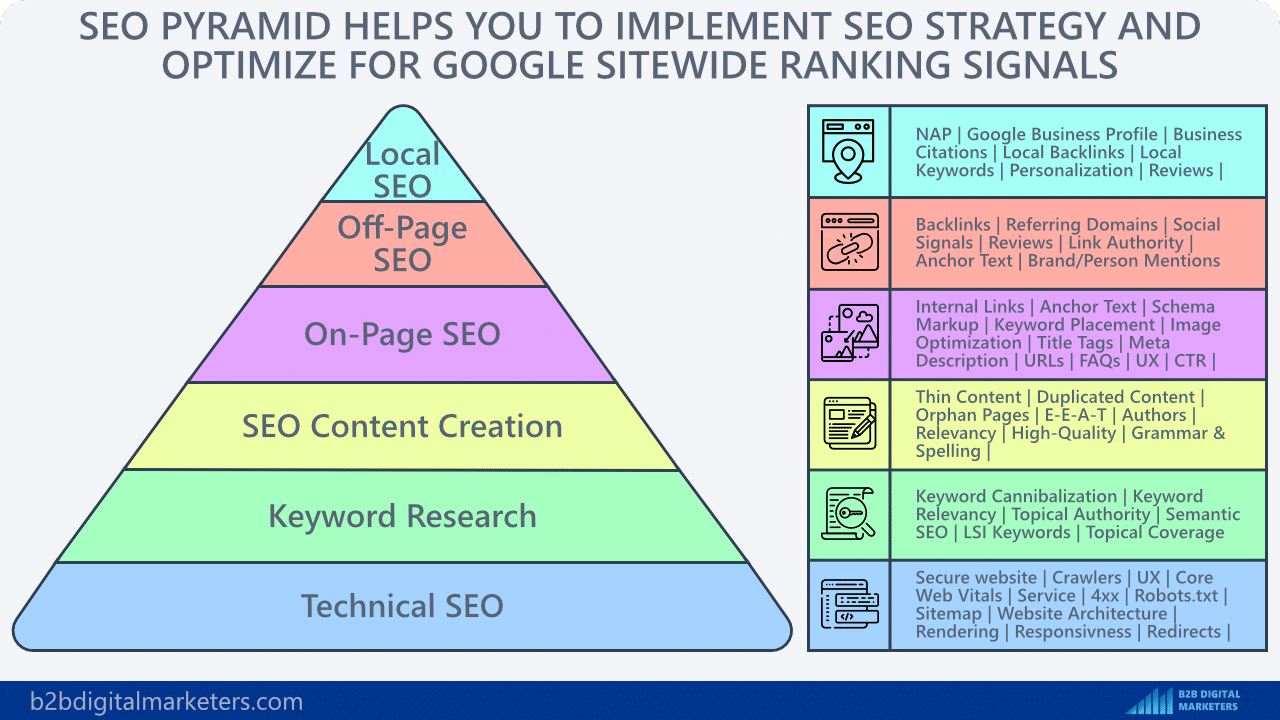
SEO Pyramid is an SEO framework that outlines a strategic step-by-step SEO process to implement fundamental SEO components of search engine optimization in order to help you understand the various aspects of SEO and prioritize their optimization efforts on your website.
By following the principles of the SEO pyramid, you can ensure you are optimizing your website and its pages in the right order. The pyramid is structured in a way that places the most important and foundational elements at the bottom, and the more advanced and complex elements at the top resulting in streamlining your SEO effort.
The Components of the SEO Pyramid
The SEO pyramid is made up of various SEO components that work together to help website owners, SEOs, and digital marketers to implement an effective SEO strategy to rank higher in search engine result pages (SERPs) and drive more organic traffic.
Each component plays a critical role in SEO and the overall success of your SEO plan.
With that, there are numerous versions of the SEO pyramid that you can use when you are planning your SEO strategy. In my version I have divided the SEO pyramid into 6 fundamental parts which are:
There are hundreds, perhaps thousands of ranking signals used by search engines and each of these SEO components will help you to optimize your website for different parts of the search engine ranking algorithm.
By implementing all the key components of the SEO pyramid, you can ensure that your website is fully optimized for search engines and that you are not missing out on any important ranking signals that could negatively impact your ranking in search results.
With that, here is the breakdown of each part of the SEO pyramid:
Technical SEO
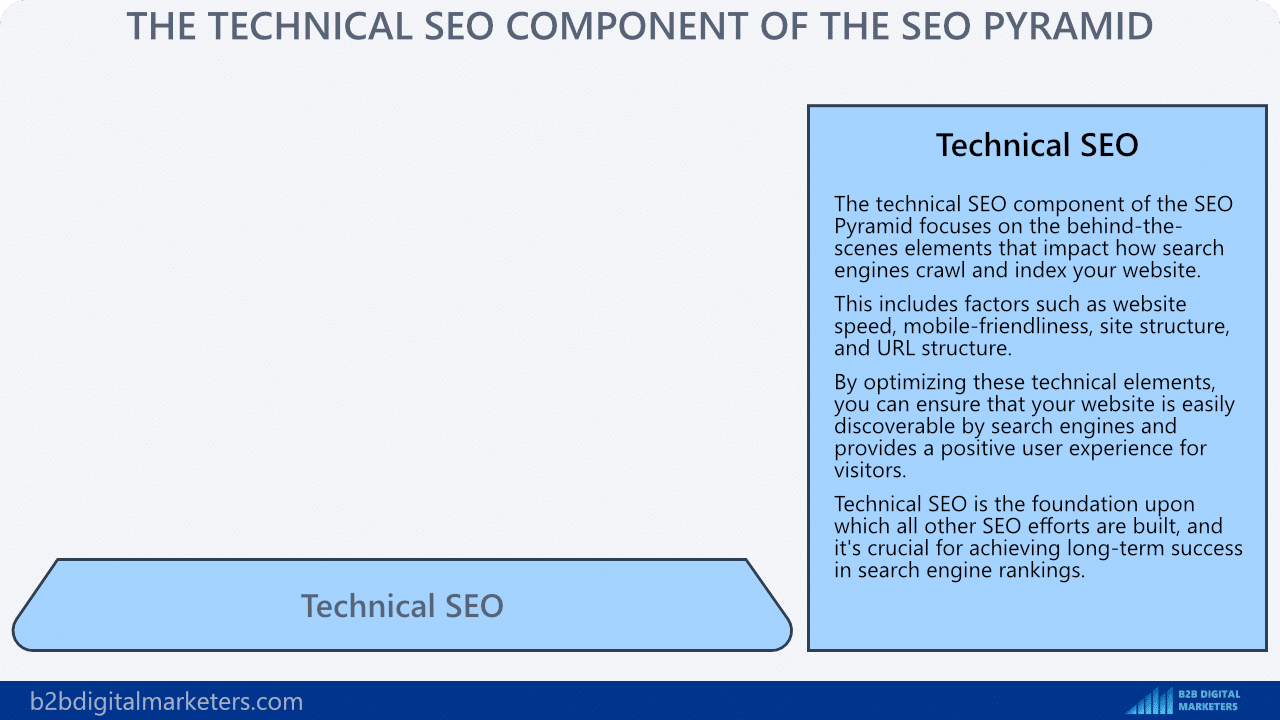
As displayed in SEO Pyramid Technical SEO is your foundation that will hold your website in place and ensure it is easily accessible and understandable by search engines as well as your website provides an optimal user experience for visiting users.
Technical SEO includes all the technical aspects of your website that affect its crawlability, performance, indexability, and visibility in search results to ensure your website and its content can be served in SERPs for relevant search queries.

And some of the technical SEO ranking factors you should optimize for are:
- Secure website connection.
- Accessible website by users and crawlers.
- Mobile friendliness.
- Optimal user experience.
- Meeting core web vitals.
- JavaScript Rendering.
- Server performance.
- Redirects
- 4xx errors
- txt file
- XML Sitemap
Keyword Research
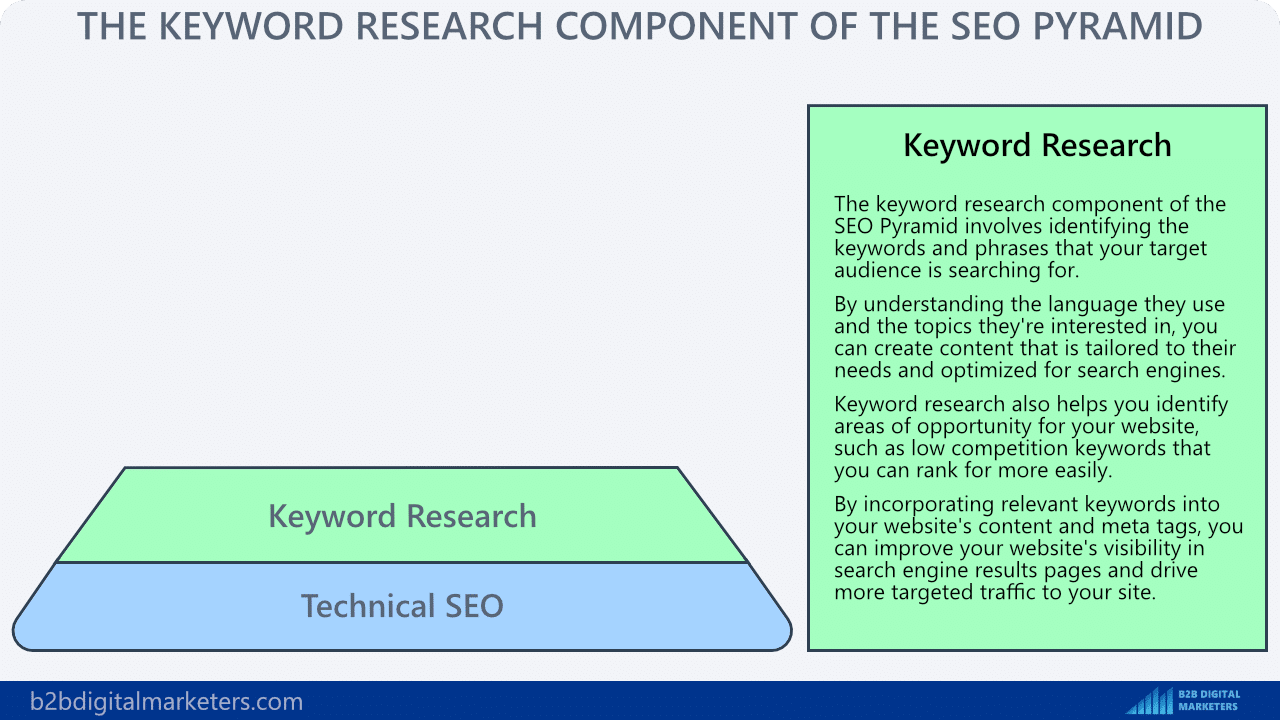
After your technical SEO foundation in the SEO pyramid, you need to find relevant keywords and topics for your website that you can write about and optimize your content for. This is a crucial step as it will determine what target audience you bring, whether you will be able to rank in SERPs, and what effort it will take.
Keyword research involves identifying the most relevant SEO keywords and topics for your website in your niche and industry that your target audience is searching for and building a topical map in order to build strong semantic SEO.
And some of the keyword ranking factors you should optimize for are;
- Keyword cannibalization
- Keyword relevancy
- Topical Authority
- Semantic SEO
- LSI Keywords
- Topical Coverage
Content Creation
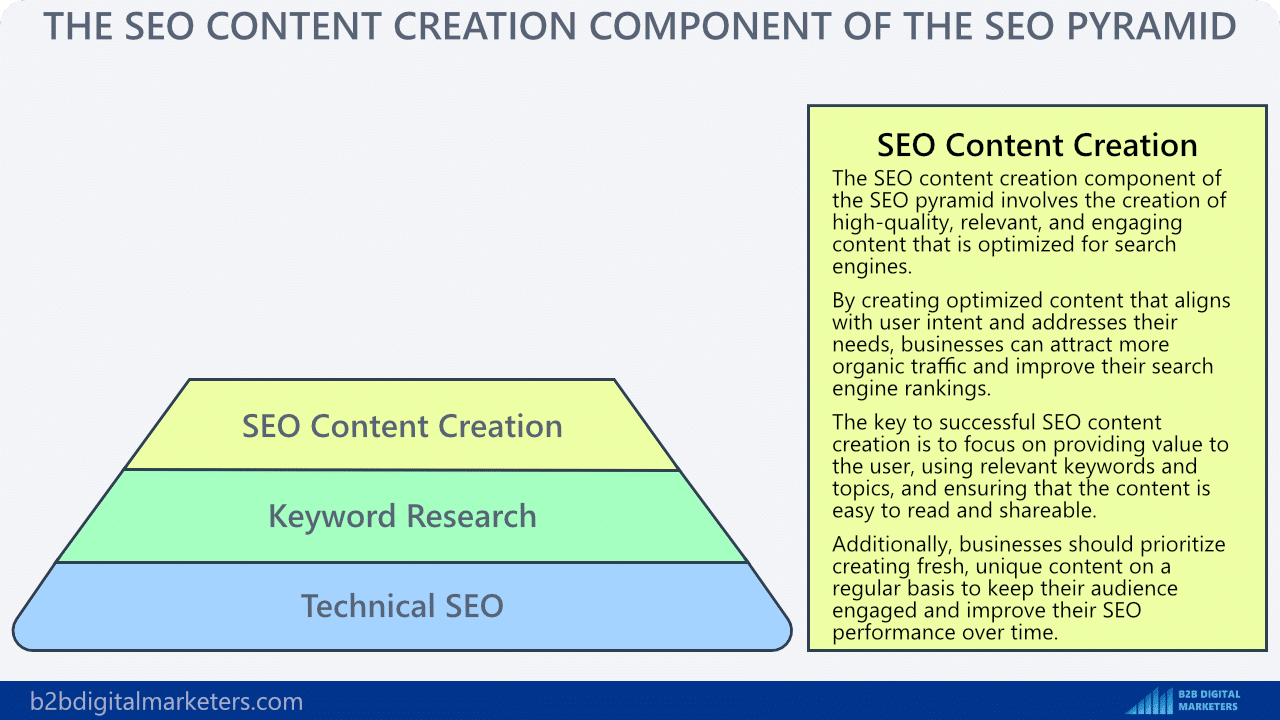
After keyword research, the next step in the SEO pyramid is content creation for the keywords and topics you have found during your keyword research.
SEO content involves creating high-quality, engaging, and relevant content for your website that provides value to your target audience and aligns with their search interest. This can include creating blog posts, product/service/category/landing pages, videos, infographics, FAQs, etc. The goal is to create content that attracts and converts visitors into customers.
Some of the content creation ranking factors you should optimize for:
- Thin content.
- Duplicated content.
- Orphan pages.
- E-E-A-T.
- Relevant content of the page.
- High-quality content on the page.
- Grammar and spelling.
On-Page SEO
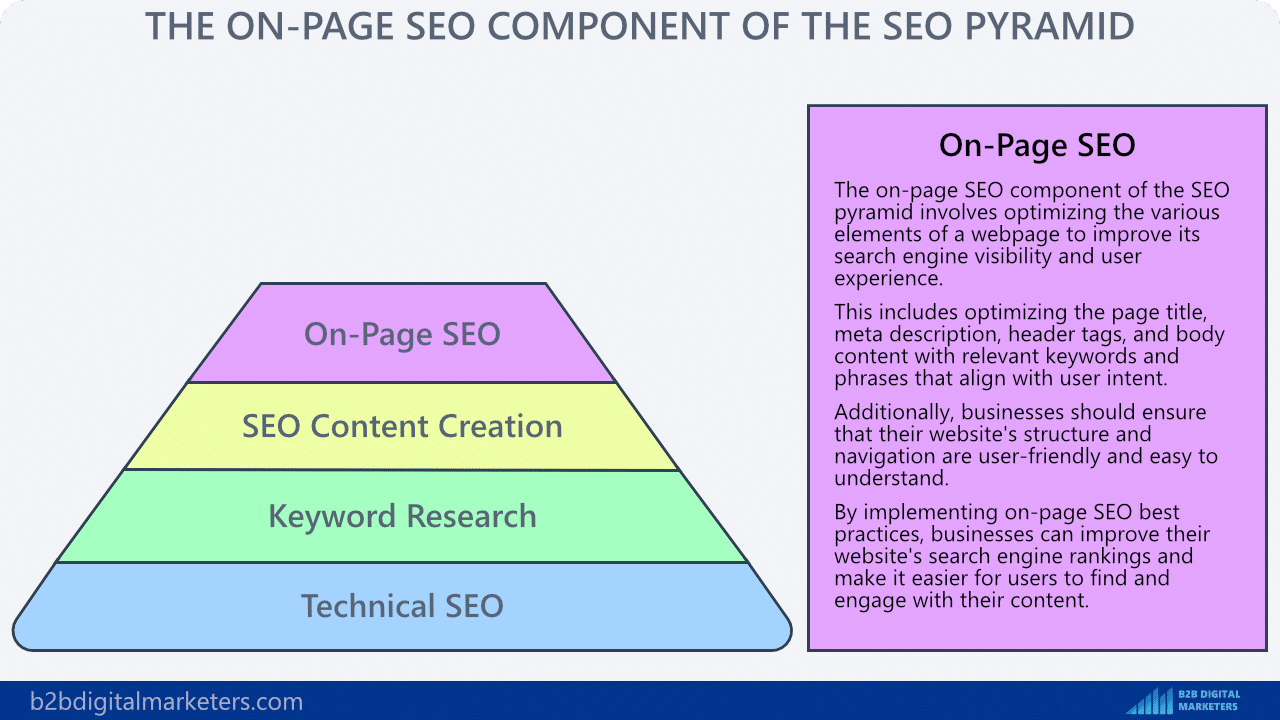
Another step in the SEO pyramid after content creation is on-page SEO.
Every time you are going to publish a new page or blog post on your website, you must ensure that your content is fully optimized for on-page SEO to maximize its visibility and relevance for search engines.
It’s important that you do most of the on-page SEO activities before you hit publish!
On-Page SEO involves optimizing your individual pages for specific keywords and topics as well as for optimal user experience.
The goal of on-page SEO is to help search engines to easier and better understand what’s your content about so they can rank it for relevant keywords and provide users with answers to their questions most shortly and efficiently.
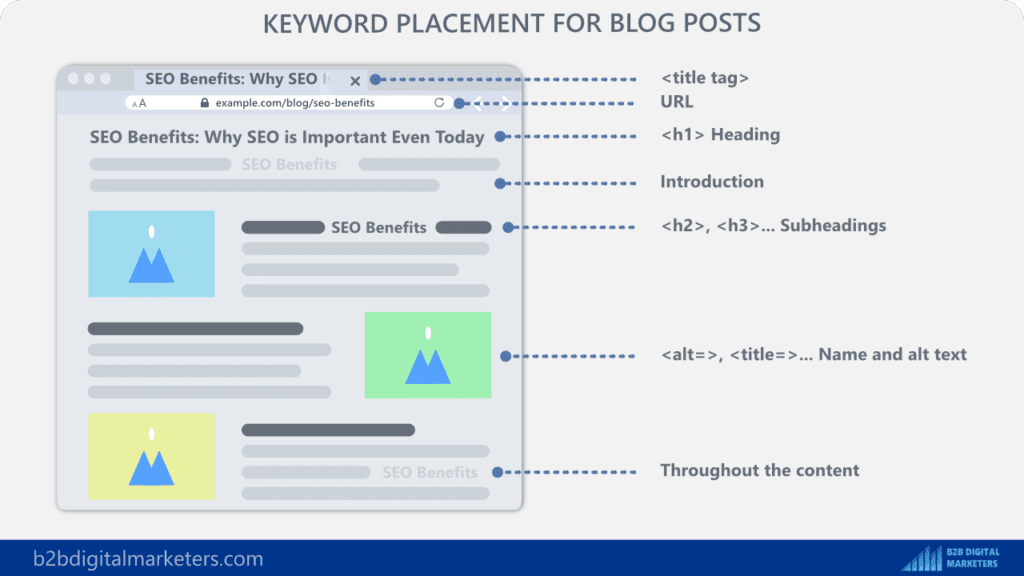
And some of the on-page SEO ranking factors you should optimize for are
- Internal links
- Anchor text
- Schema markup
- Keyword placement
- Image optimization
- Title tags
- Meta description
- Page URLs
- FAQs
- User experience metrics
- Click-through rate
Off-Page SEO
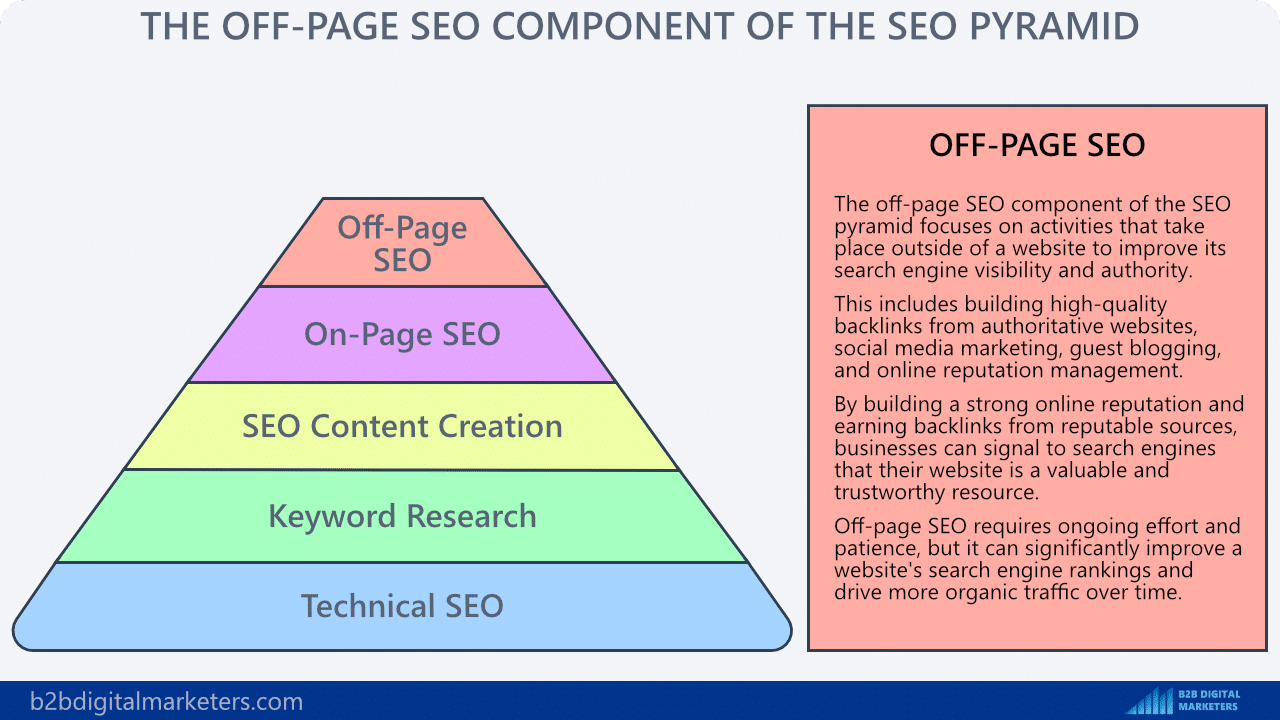
Once you start having a sufficient number of pages on your website (I would say at least 30), then the next step in the SEO pyramid is to build an online reputation for yourself and your website through off-page SEO techniques.
Off-Page SEO is about building your online reputation on the internet by building high-quality backlinks, having an active social media presence, and managing online reviews in order to increase your website’s authority and improve its ranking in search results.
And some of the off-page SEO ranking factors you should optimize for are:
- Social signals
- Reviews
- Link authority
- Number of Referring Domains
- Anchor text
- Brand mentions
Local SEO
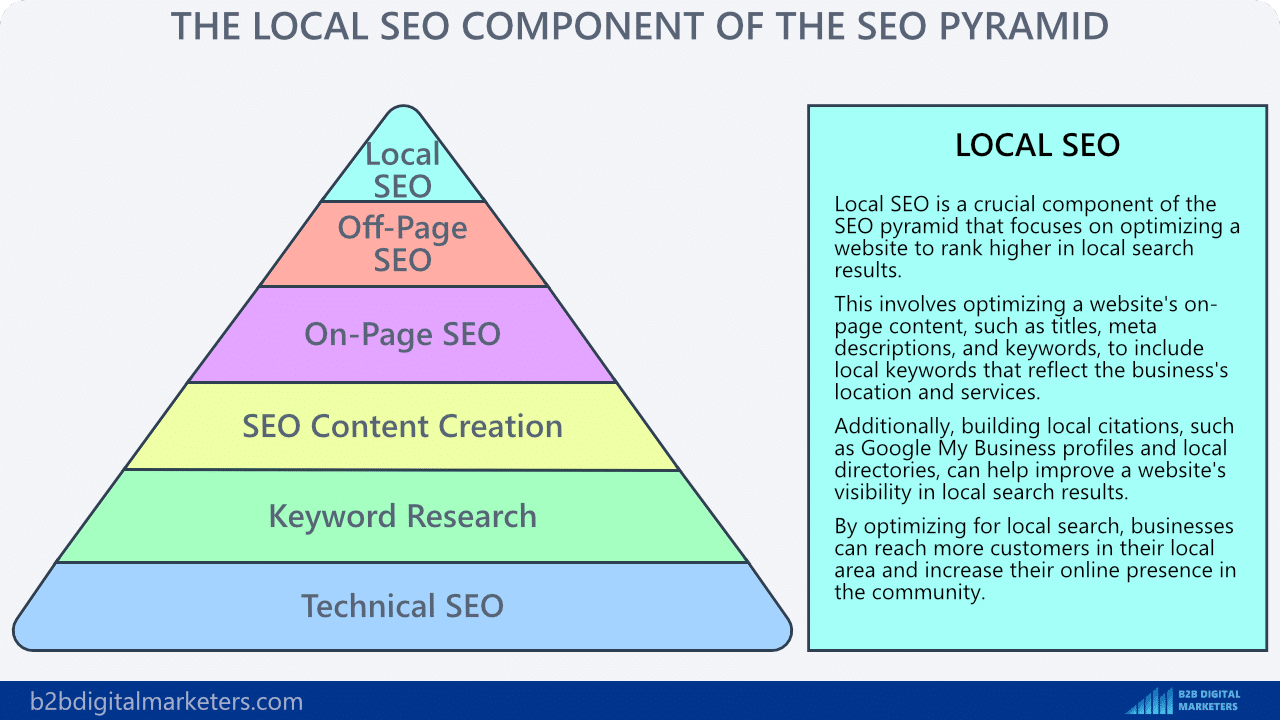
And on the tip of the SEO pyramid is Local SEO. For most businesses, local SEO can play important role in increasing brand awareness among local customers and driving more website traffic or foot traffic to the website, online, or offline store.
Local SEO involves optimizing your website and its content for local keywords and local search results in order to attract the local target audience. This strategy can be used by both local and international brands as in most cases users are searching for a local version of products or services.
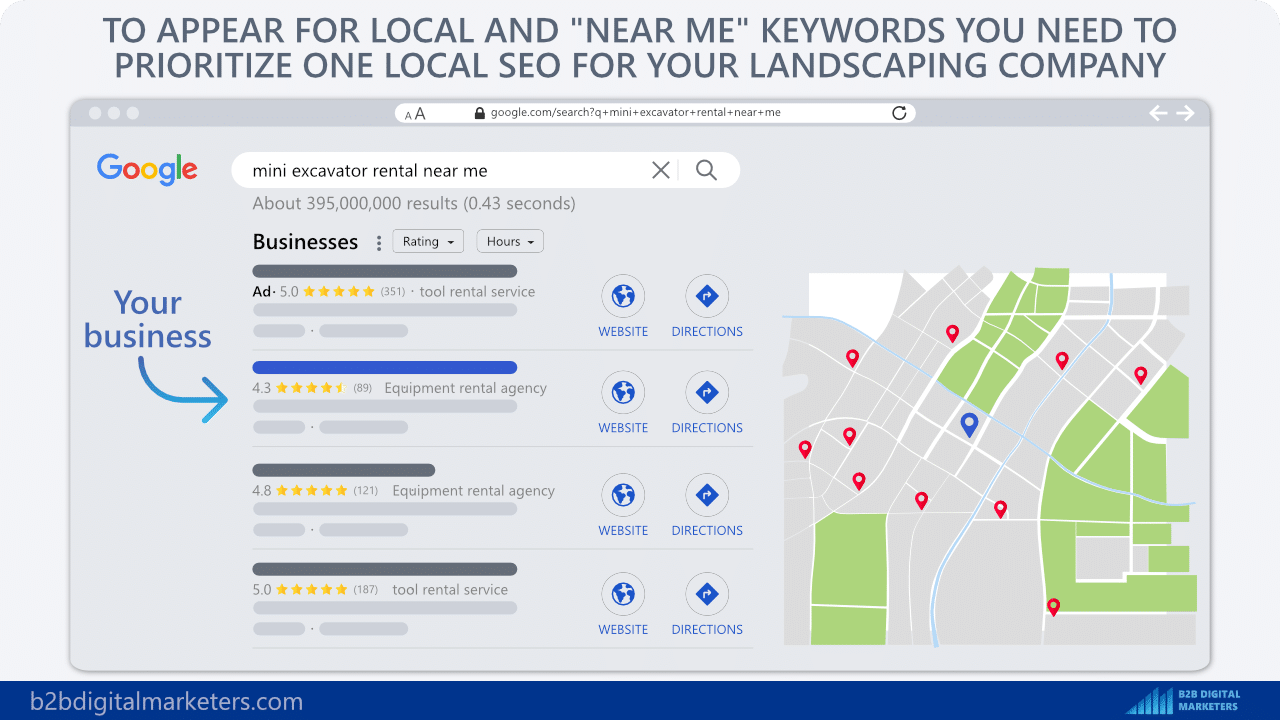
And some of the Local SEO ranking factors you should optimize for are:
- Consistent NAP
- Google Business Profile
- Business Citations
- Local backlinks
- On-page content
- Personalization
- Keywords in reviews
- Spam listing
Implementing SEO Pyramid Best Practices for Every SEO Component
Implementing an effective SEO pyramid strategy requires optimizing your website for different ranking factors of each SEO component.
To do this, it’s important to learn the best practices of each SEO component that influences the particular ranking factor.
So, here I will share with you some of the SEO best practices that you should implement for each SEO component to optimize for their specific ranking factors.
Implementing Technical SEO Best Practices
Technical SEO is the fundamental part of SEO strategy as without that your website will not be able to rank regardless your content is great, you have a ton of links coming to it, or you are regarded as the expert in the industry.
Technical SEO ensures that your website is accessible by both users and search engines, delivers the optimal user experience, and the content can be read by users and search engines.
Therefore, here are the most important technical SEO best practices that you should optimize for:
- Implement Robot.txt file: This file will tell Google and other search engines which pages or sections of your website to crawl and which not to. In most cases, you will want to avoid only admin or members-private sections of your website.
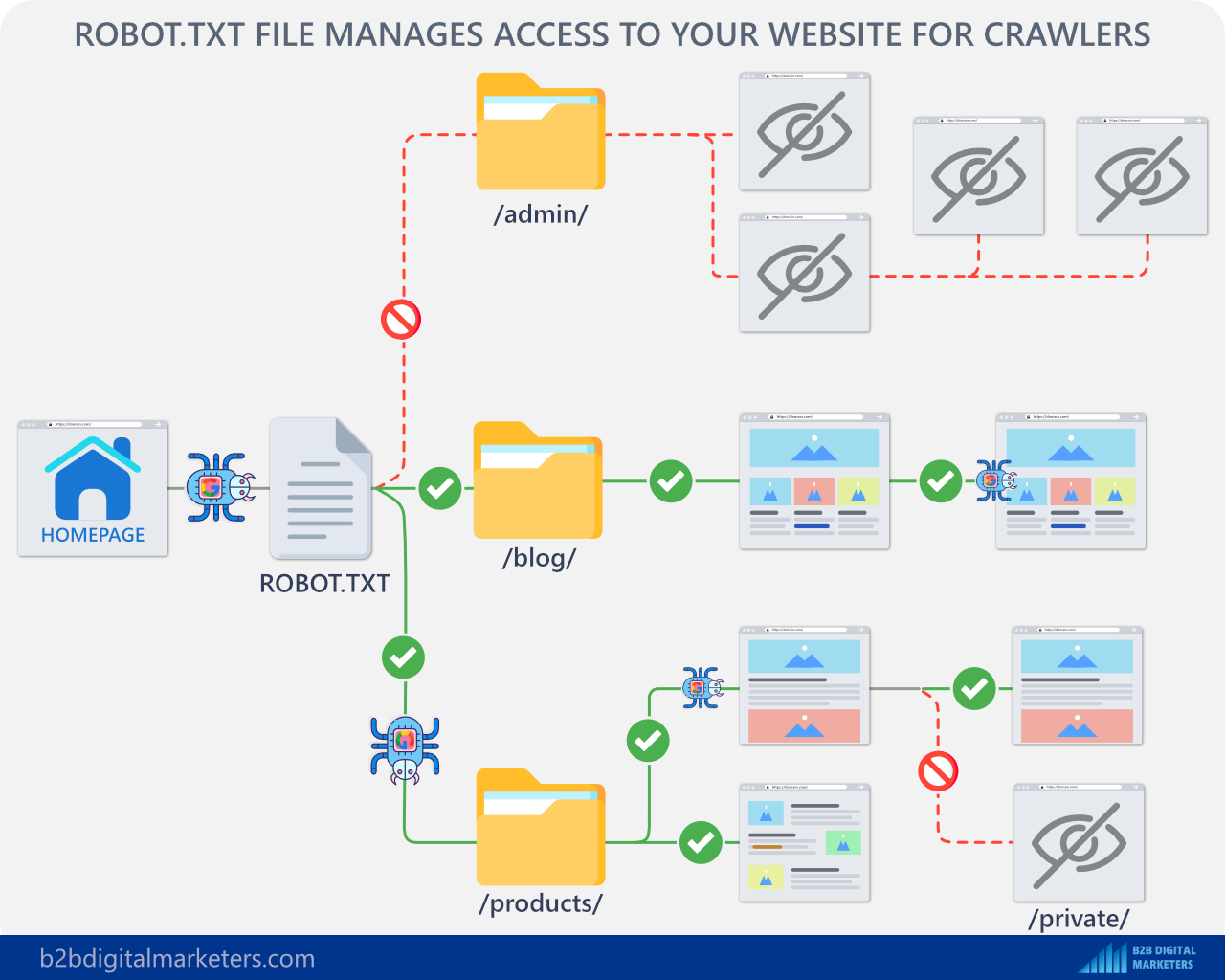
- Implement XML sitemap: Search engines use sitemaps to discover new pages and receive notifications about updated pages. Although sitemaps are the secondary method for discovering new pages, it’s essential to have sitemaps for your pages and images to ensure their discoverability.
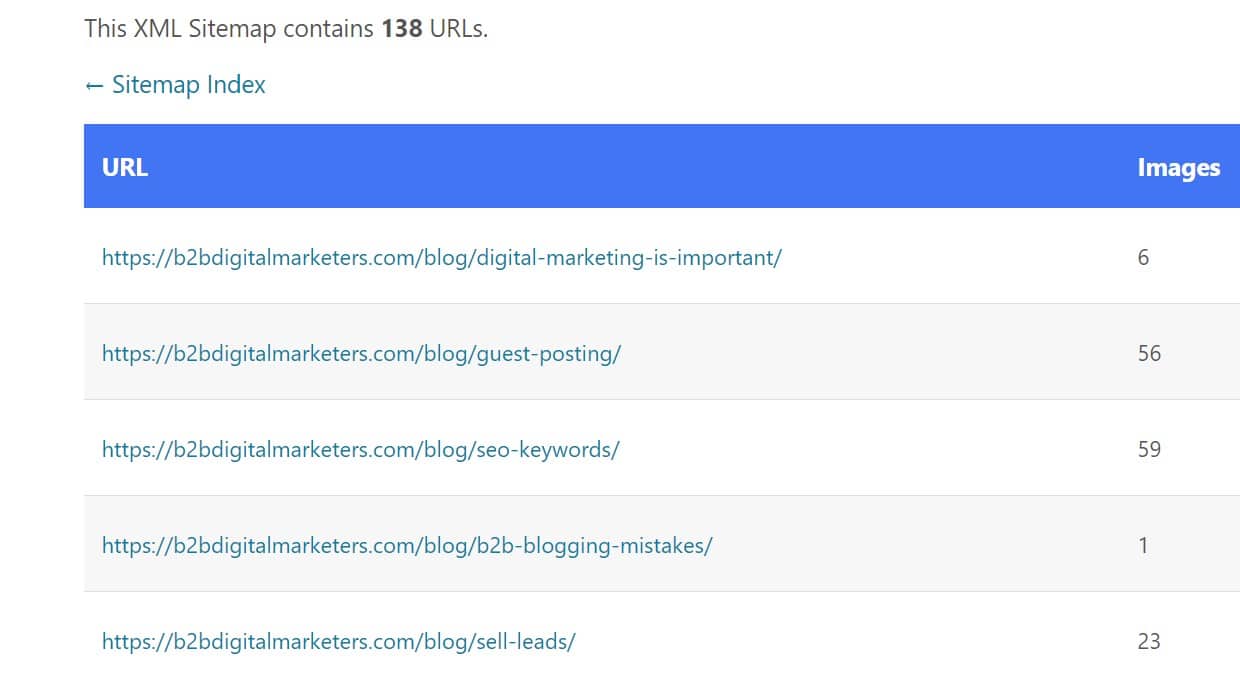
- Use HTTPs: Security is a priority for Google. If your website is not secure, Google won’t trust it to send the traffic there. So, make sure your website has SSL certification. Additionally, I recommend to also use a security plugin.
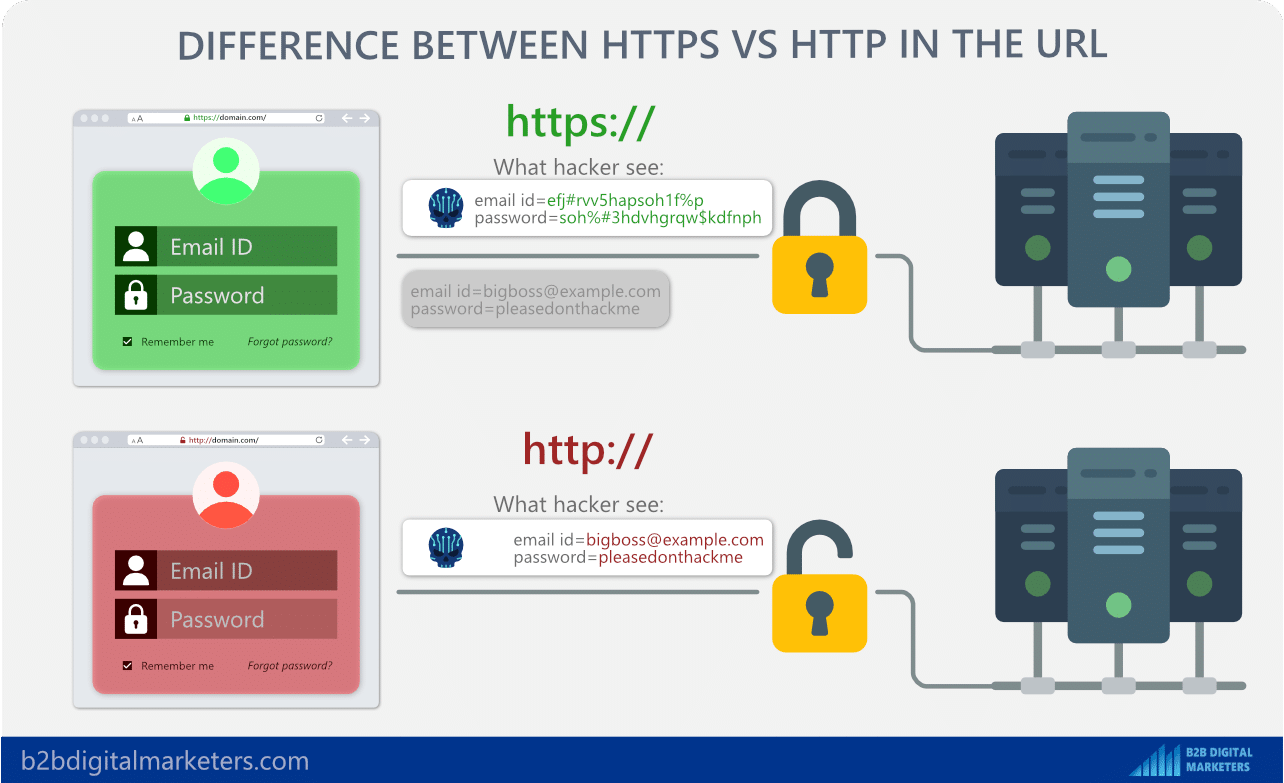
- Meet the Core Web Vitals: Page speed is one of the user experience metrics Google tracks. If your website does not provide optimal user experience, it can prioritize websites with similar information but better page speed. I mean what’s the point to have the best content if it doesn’t load?
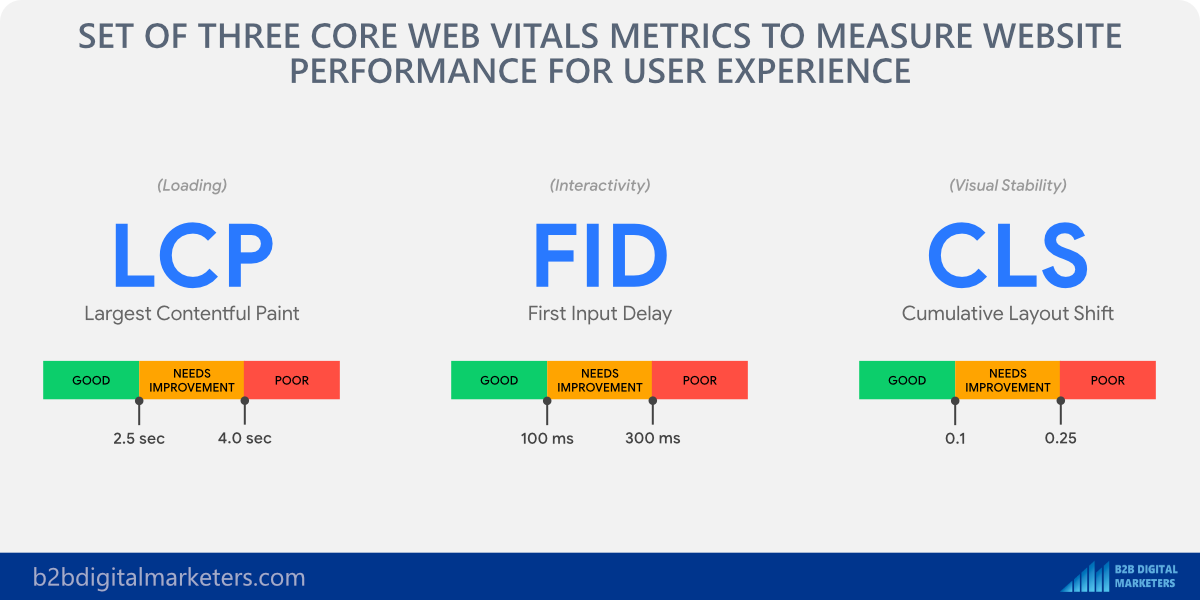
- Reduce Bounce Rate: The bounce rate shows how well you have served your users. If people bounce back from your site and go somewhere else, it can mean you are not delivering the right user experience.
- Ensure Responsive Website Design: Mobile-first indexing has been here for a while. If your website cannot be indexed for mobile devices, you might end up not being indexed at all. So, make sure you have a responsive website design.
- Canonicalize Main Pages: Some of the websites such as eCommerce have many different versions of the same pages. So, it’s important that you indicate which one of those versions is the main one.
- Use Caching Plugin: These plugins help you to optimize your HMTL, CSS, JavaScript, and other files to improve your page speed and user experience. So, if you’re using WordPress, then you should implement caching plugin such as WP Rocket.
- Limit Internal Redirects: While it’s inevitable to make changes on your website, you should always minimize any internal redirects on your website to optimally 0 and update all your internal links to your new page. However, make sure to set up the redirects anyway for any external links.
- Remove any 4xx errors: You should make sure, you don’t have any 4xx errors on your website, especially internal 404 errors.
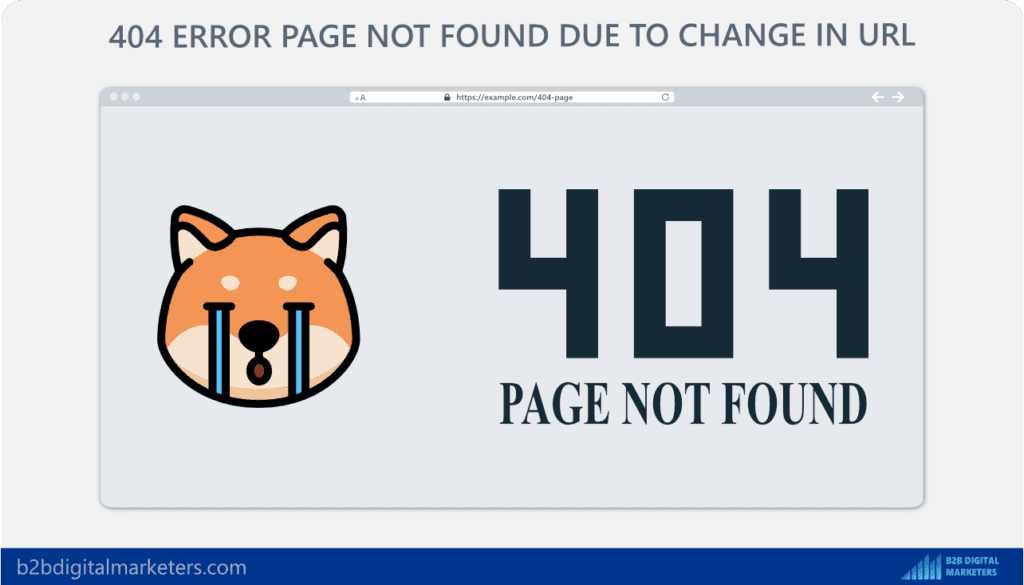
- Optimize Website Architecture: Having well-planned website architecture will ensure website crawlers can access all your pages in the shortest way and your users can easily find information.
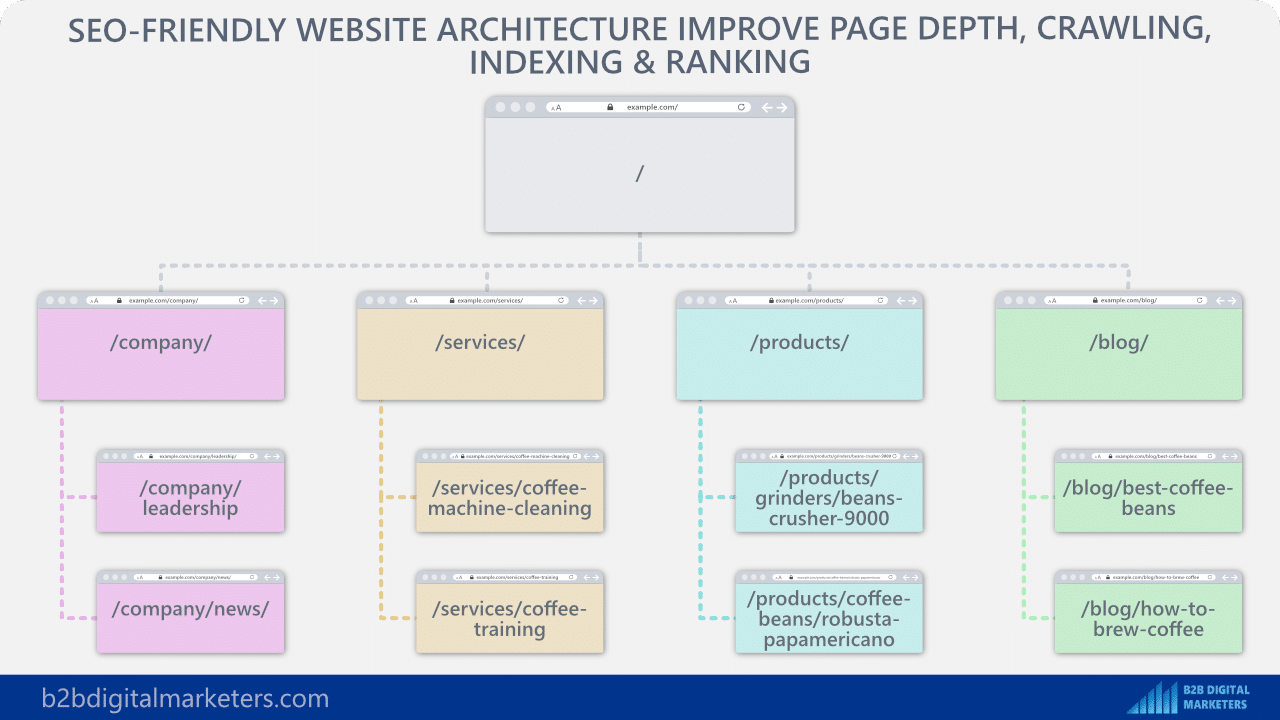
Following these technical SEO best practices will help you to optimize your website for the most important technical SEO ranking factors to ensure your website is not being penalized or at disadvantage over others.
Implementing Best Practices for Keyword Research
The next part of the SEO pyramid is the keywords research which will determine your entire SEO success as the SEO keywords that you will be targeting will directly influence how much organic traffic you will bring to your website, what type of target audience you attract, and in what niche or industry Google will put you.
All this and more keyword research influence. That’s why keyword research is so important, and a significant part of planning SEO strategy should be devoted to keyword research.
With that, here are some of the keyword research best practices:
- Create Topic Clusters: Creating topic clusters relevant to your products or services will help you to target relevant keywords that can attract potential customers to your website across all stages of the buyer journey.
- Crease SEO Funnel: When you are doing keyword research is important to ensure, you are having keywords across all stages of the SEO funnel by targeting keywords with all types of search intent.
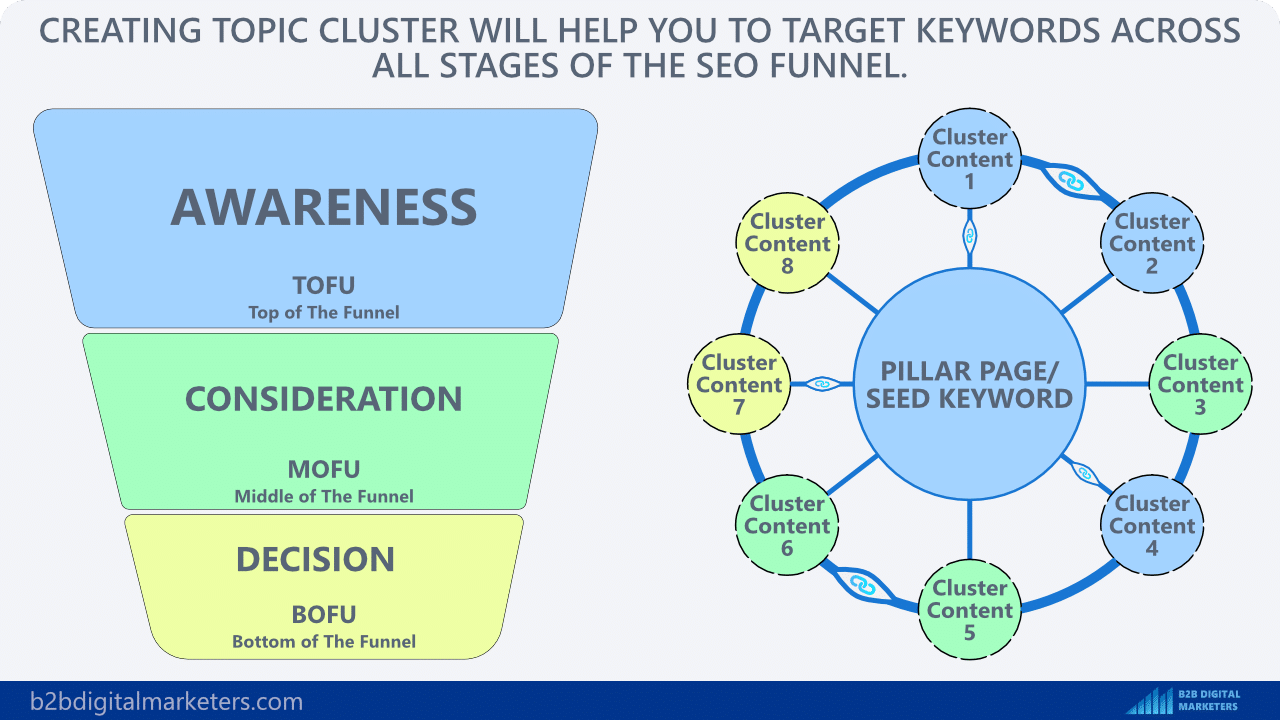
- Build Topical Map: Having a lot of content is one of the keys to dominate in the search results, but it cannot be just any content, but closely relevant to your niche or industry. Through this, you can ensure you are dominating in SERPs within your niche and drive brand awareness to your target audience. Additionally, this will help you increase your E-E-A-T.
- Focus On SEO Lead Generation: To be able to drive SEO leads or increase your revenue via SEO, you need to understand how your potential buyers are using search from the early stage all the way to the end of the buyer journey.
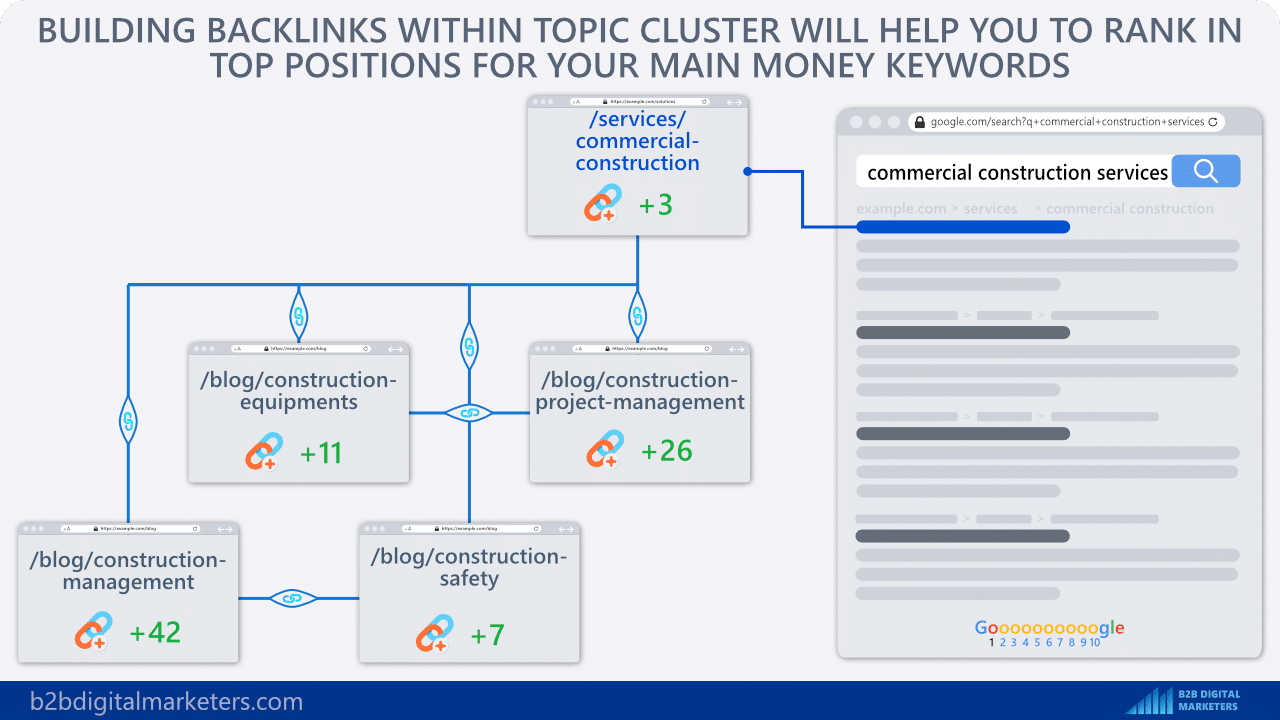
- Find Profitable Keywords: By finding the right keywords that can bring you potential customers will help you to complete your SEO funnel and SEO lead generation and maximize your SEO ROI.
- Understand Primary Keywords: Understanding what keywords you can target and what keywords you cannot help you to maximize your SEO effort, time, and resources.
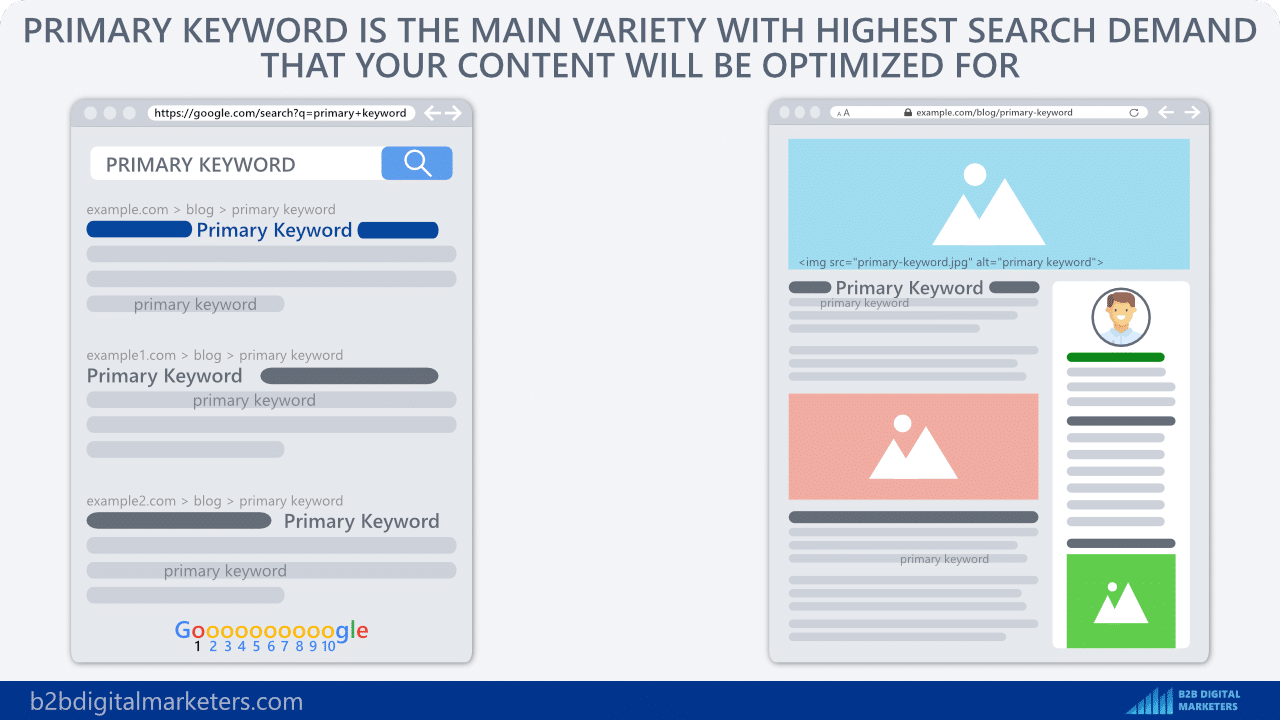
- Understand LSI Keywords: Understanding what keywords to use when you are creating content on your website will help you to improve ranking, maximize your search visibility and traffic and bring you higher ROI.
- Find Long-Tail Keywords: These keywords often have lower search volume, but they are easier to rank for because they are less attractive to large websites, and usually they have higher conversion rates because they are more targeted and attract higher quality traffic.
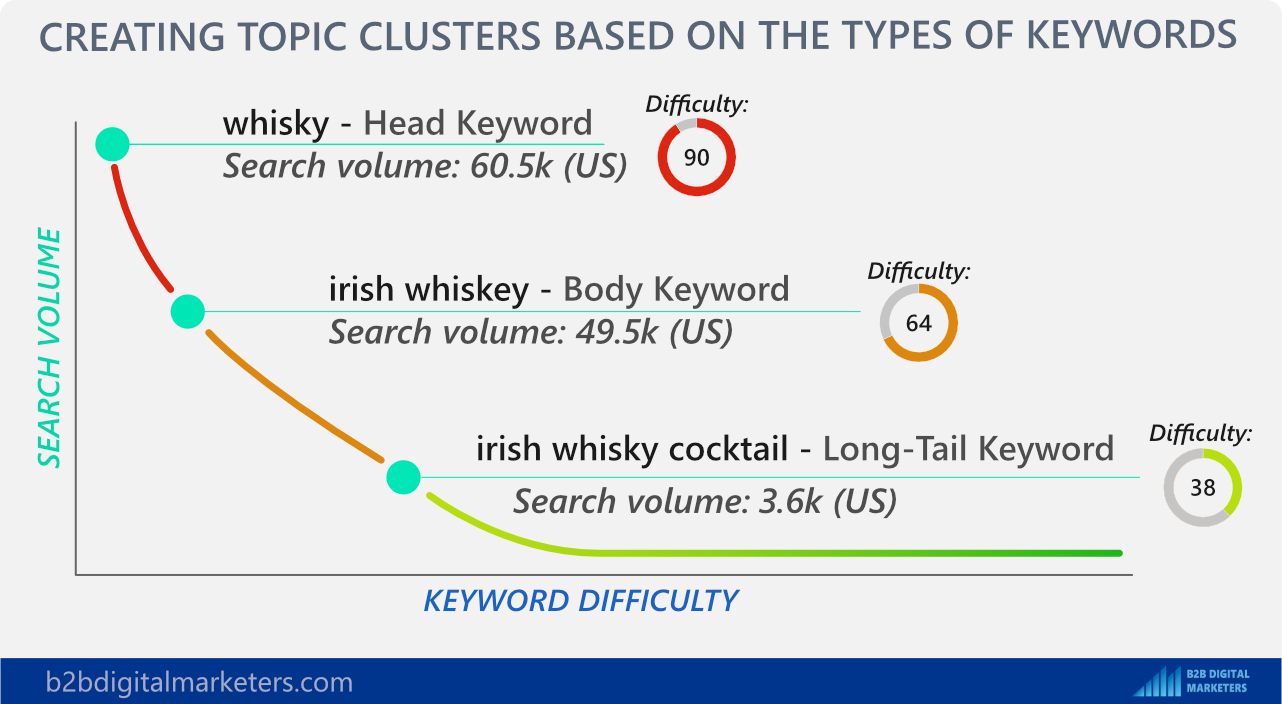
- Target Informational Keywords: Targeting informational keywords will help you to increase your brand awareness, attract buyers at the early stage of the buyer journey, and ultimately build website authority and trust within your niche.
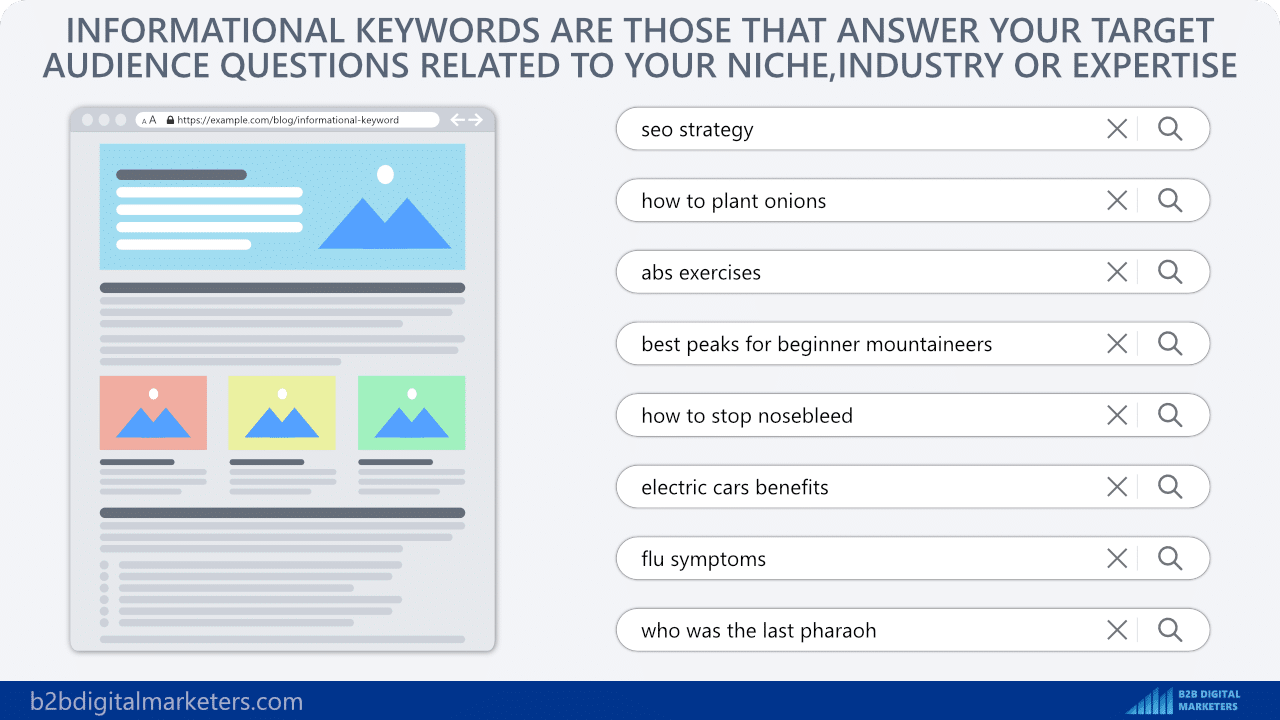
Overall, keyword research is another fundamental part of the SEO pyramid and arguably the most important as it will determine your SEO success.
Therefore, your keyword research should be thorough, while assessing your ability to produce content. The less content you can produce on weekly basis, the more selective you will need to be about what keywords you can target.
Implementing Content Creation Best Practices
Once you have completed your keyword research and you have a list of keywords and topics related to your niche or industry to write about, the next part of the SEO pyramid is to create content on your website.
This is where you differentiate yourself and need to give plenty of reasons why Google and other search engines should rank you for your target keywords.
So, with that, here are some of the SEO content creation best practices:
- Focus on Evergreen Content: Unless you’re news related website, you will want to cover evergreen topics that people search for consistently throughout the years, you want to avoid seasonal topics such as “how to sky” or “what to wear for Halloween”.
- Create All Types of Content: Unless you are an affiliate website or content-based website, you will want to create all types of pages including product or service pages, category pages, resource pages, team & about us pages, case studies, etc. Not all, will be targeting keywords, but each type of page has its purpose.
- Target Only One Primary Keyword per Page: To avoid confusing Google and users, you should optimize your page only for one primary keyword. Through this, you can avoid duplicated content.
- Create a Logical Outline: Before you write anything, first create a logical outline of your content and where you want to go with it. Through this, you ensure you don’t drift away from the topic but you will stay focused and deliver the most value and you create high-quality content.
- Focus on Your Expertise & Experience: Google is looking for experts with experience within the industry as like that they can deliver the best content to their users. Therefore, you should always include your expertise and experience within every piece of content, especially blog posts. Like this, you can build your E-E-A-T on your website.
- Start with Easy-to-Rank Keywords: At the beginning, your website authority is very small, and you will have a hard time ranking in the top 100 for your target keywords, so first start with easy-to-rank keywords to build up your website authority.
- Meet the Search Intent: It’s essential that with every keyword you are targeting you are meeting the search intent as Google became a semantic search engine focusing on the user intent behind each search query. Thus, you must ensure you create content that aligns with the user needs of your target keywords. Basically, just follow the type of content that ranks in the top 10.
- Use Custom Multimedia: To enhance the user experience and engagement, include custom multimedia like images, videos, infographics, and other visuals related to your content. This will help in making your content more attractive, informative, shareable, and linkable.
- Use SEO Copywriting: Use effective SEO copywriting techniques like catchy headlines, meta descriptions, use of keywords in the right density, and easy-to-read content to improve your content’s readability, visibility, and rankability.
- Follow 80/20 SERP Format: Google has a problem with copycat content, where many websites simply duplicate the top 10 search results in an effort to rank higher. In response, Google has shifted its focus towards “Informational Gain” – content that provides more value and insight compared to the existing results. To meet the search intent, it is recommended that 80% of your content follows the existing search results without copying them, while the remaining 20% should showcase your own unique style, ideas, and information.
- Create Lead Generation Strategy: Implement lead generation strategies within your content, such as call-to-action buttons, forms, lead magnets, or links to your services or products, to convert your visitors into potential customers.
- Assign Authors to Each Blog: To establish authority and expertise, assign authors to each blog post, and include their author bio to help in building E-E-A-T signals. This will also help in creating a personal connection with your audience and building trust.
- Avoid Thin Content: Thin content refers to pages or blog posts that lack substance or value to the user, typically containing fewer than 200 words or duplicate content. It’s important to avoid thin content as it can harm your website’s credibility, user experience, and SEO rankings.
Following these SEO Content, best practices will help you to optimize your content for important ranking signals that Google uses when evaluating your website for ranking.
So, make sure you implement as many as you can in order to meet Google ranking signals.
Implementing On-Page SEO Best Practices
On-Page SEO is arguably one of the easiest parts of SEO and the SEO pyramid as you have total control over it and you can really help search engines to better understand what’s your page about which often results in better ranking.
Therefore, here are some of the on-page SEO best practices that you should implement to meet Google sitewide ranking signals:
- Focus on Keyword Placement: Google said that if you want to tell them what’s the page about make the as visible as possible. Your goal is to make it as easy for Google to understand what’s your page about as possible without keyword stuffing. (Check out Where and How to Add Keywords in WordPress.)
- Create SEO Friendly URLs: URLs play a vital role for search engines to understand what’s the page about. Therefore, adding only a primary keyword in your URL will make it evergreen and follow the best practices.
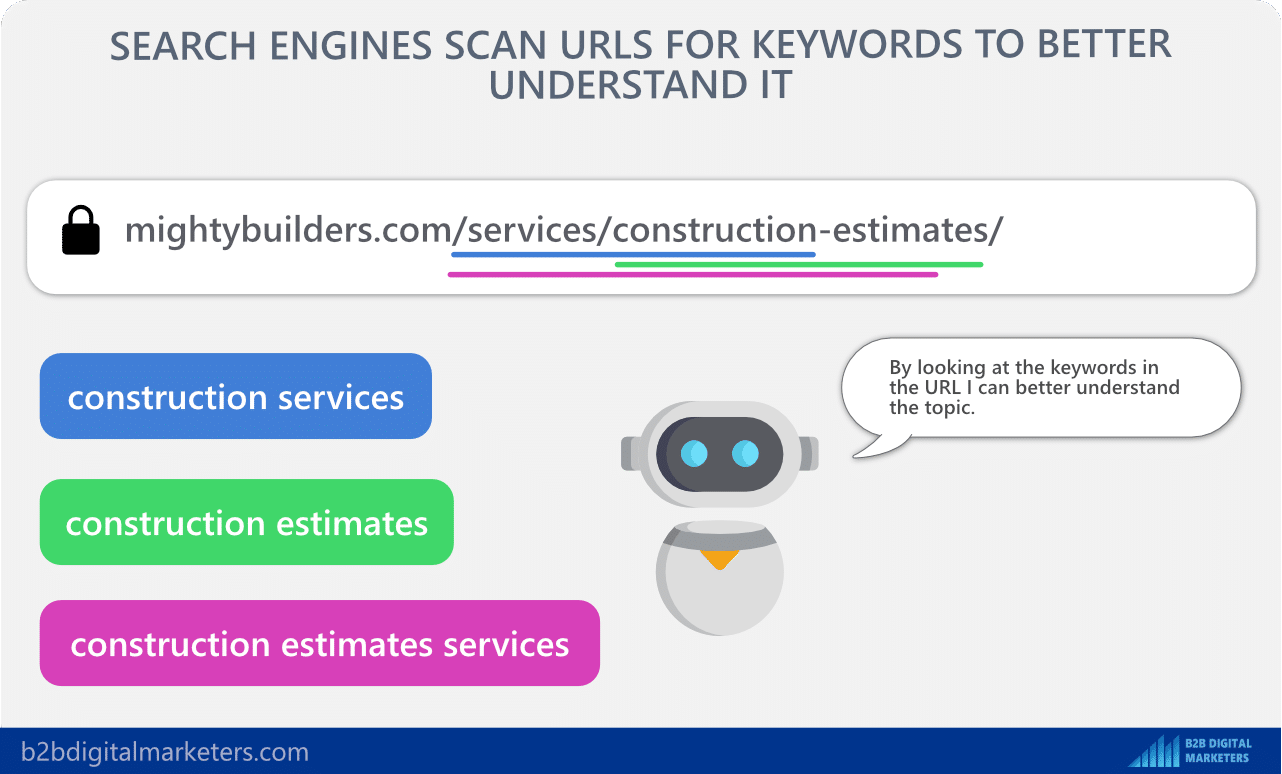
- Create SEO-Friendly Headlines: As said, you should create a logical outline of your content, but you should also SEO your headlines as Google is using headlines to better understand what’s the page about.
- Create an Internal Linking Strategy: The number #1 way how Google is discovering content is by crawling links. By having a proper internal linking strategy, you ensure all your pages are easily accessible by crawlers and users. Additionally, they pass PageRank helping you to increase your overall ranking.
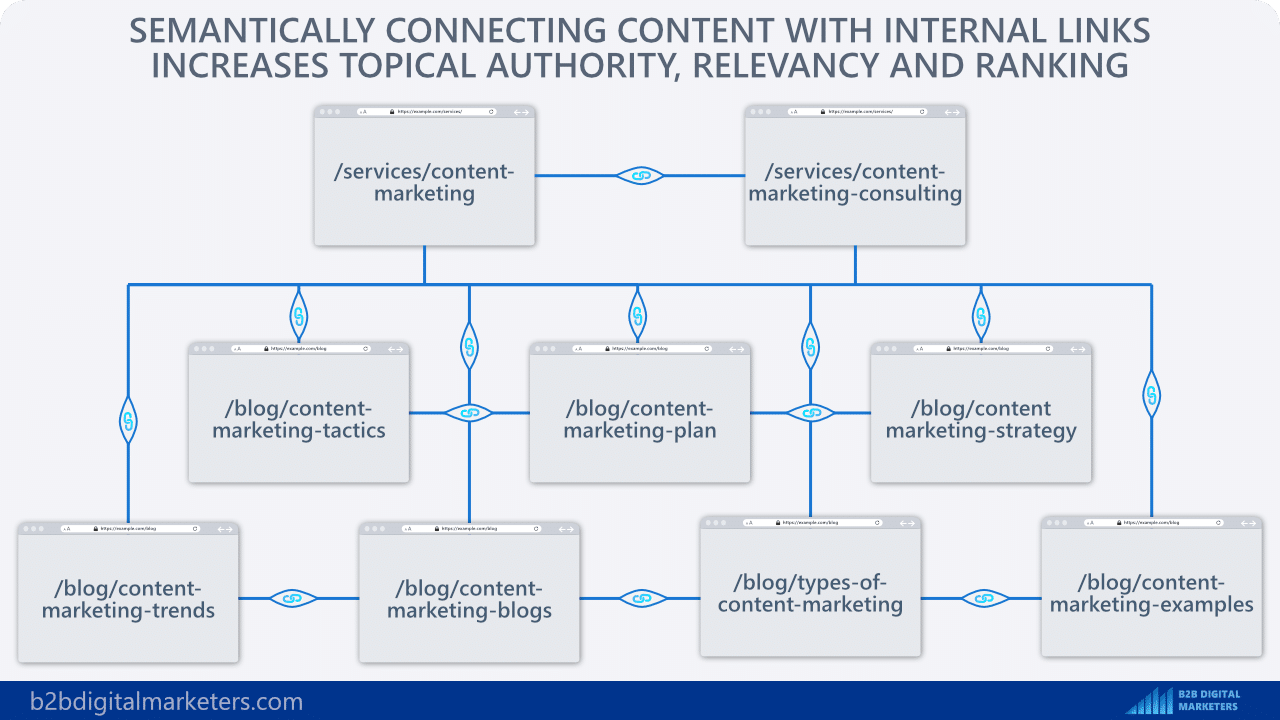
- Create SEO Friendly Images: Images are an important part of the content and they can also drive you targeted organic traffic via image search. Having optimized images will help Google to better understand your content and rank you for relevant search queries in image search. Also, it will help with your page speed.
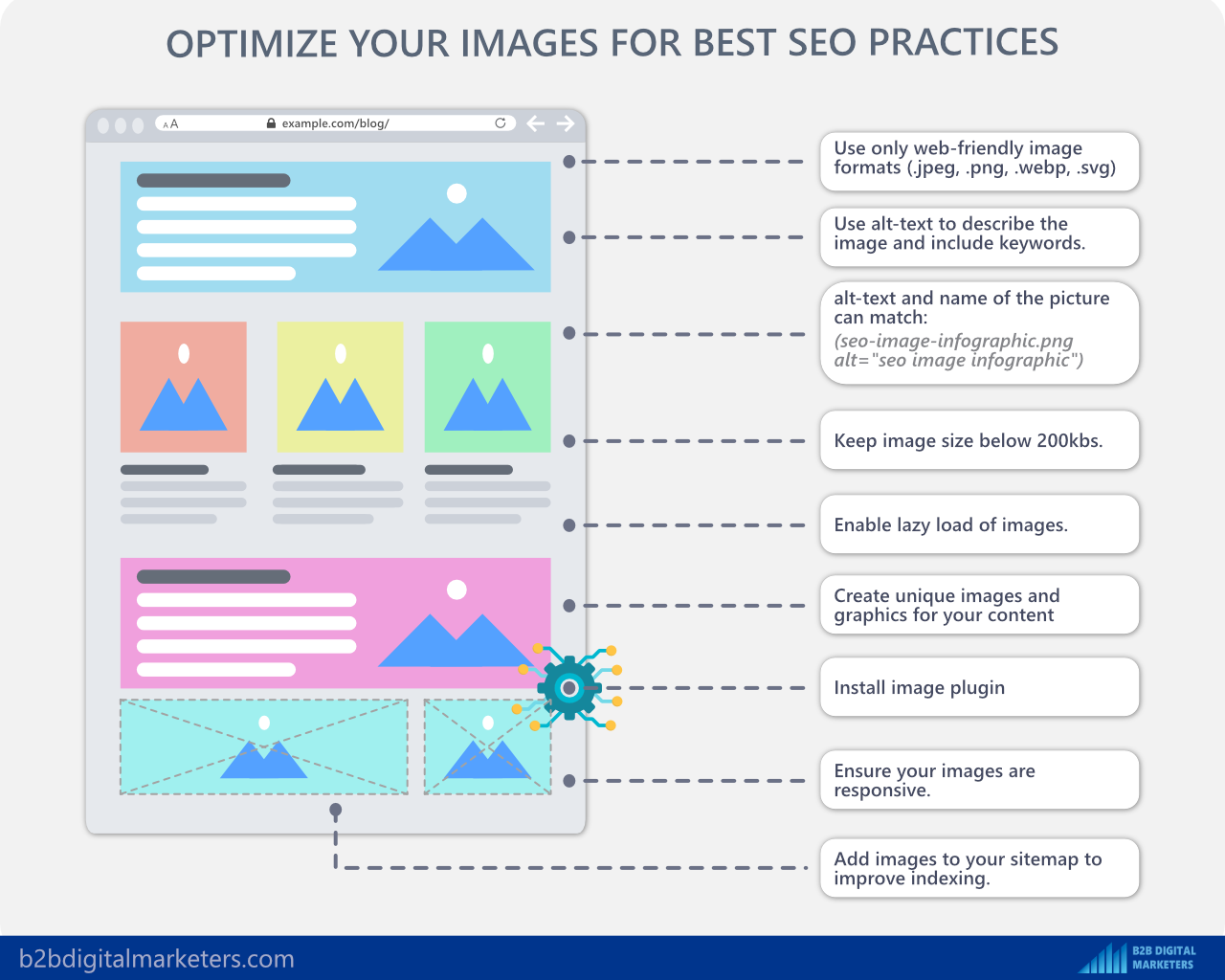
- Include LSI Keywords: Google is a semantic search engine, and it does not need you to stuff keywords to understand the content. Instead, you should use relevant LSI keywords to further improve the understanding of the content and improve your ranking for more related terms, resulting in increased website traffic potential.
- Include External Links: Linking to other relevant and high-quality sources can help increase your website’s credibility and authority, which in turn can improve your ranking.
- Include Breadcrumbs: Breadcrumbs provide a clear and structured navigation path for both users and search engines, making it easier for them to understand the structure and hierarchy of your website.
- Create Title Tag & Meta Description: Title tags and meta descriptions are the first things that users see in search results, so they play a crucial role in attracting clicks and driving traffic to your website. Make sure to create compelling and keyword-rich title tags and meta descriptions for each page.
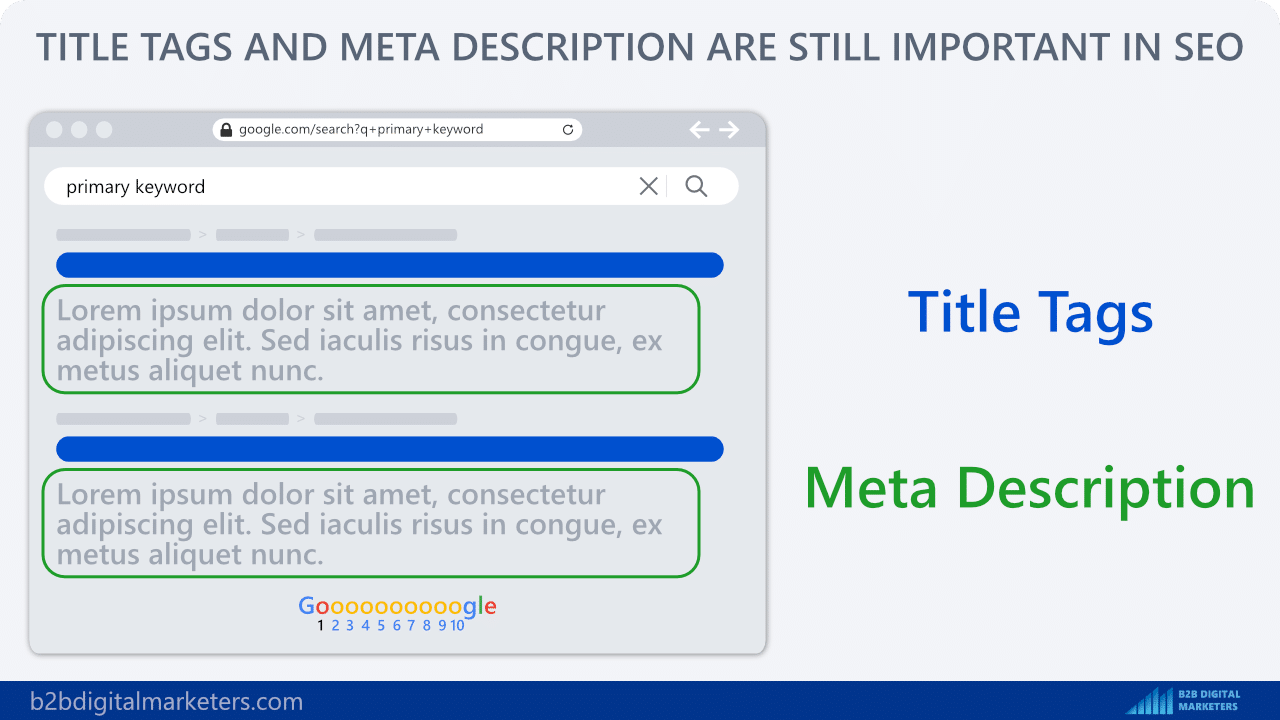
- Add Relevant Schema Markup: Schema Markup helps search engines to get important information about the page in a way they prefer. By including it on your page you can improve your ranking and rank in some of their rich results.
- Add Relevant FAQs: Including FAQs on your page helps provide more value to your users. Additionally, you can increase your chances of ranking in the “People Also Ask” box or featured snippet, increasing your traffic and SEO potential.
- Focus on CTR Optimization: Click-through rate optimization involves improving your website’s search result snippets to encourage more clicks. This can be achieved by crafting compelling titles and meta descriptions that accurately reflect the content on the page and entice users to click through
- Provide Answers Upfront: Time on-page does not play a significant factor nowadays as Google wants to satisfy the user’s needs in the fastest way. That means if you want to succeed in your search, provide your answers upfront in the forms of TL;DR:, bullet points, answer box, or other means.
Again, following these best practices will help you to meet the Google ranking signals in order to boost your website ranking and meet the Google sitewide signals that they use to evaluate your websites for ranking.
Implementing Off-Page SEO Best Practices
Off-page SEO is all about building a reputation for your website and person in an eyes of users and search engines. The higher the reputation you have in your industry, the more competitive you become and the better and more prominent topics you can target.
With that, here are some of the off-page SEO best practices to improve your ranking:
- Make Your Content Sharable: Making your content more sharable will send important signals to Google that your content is valuable to your users. Therefore, adding social media share buttons for each of your content as well as following shareable content best practices will help you to optimize for this.
- If Possible Collect Reviews: If you are a business, you want to be collecting reviews, be it on your own business listings or other relevant listings. These reviews are not only used by users, but by also search engines when they are assessing your website for ranking.
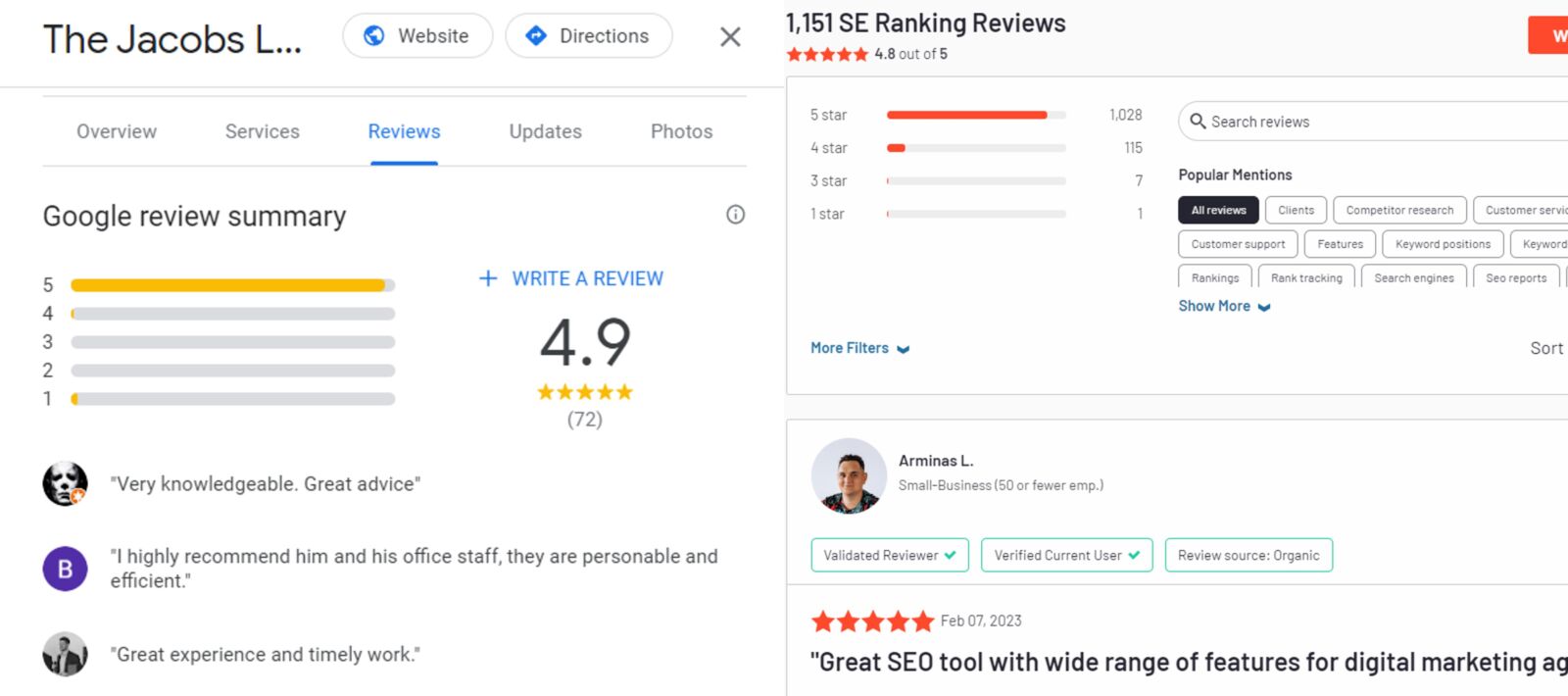
- Register Yourself at Relevant Business Directories: Regardless you are a business or blogger, you can register yourself at relevant business directories and help search engines to better understand what’s your page about. Additionally, data like these can be used during ranking your website.
- Build High-Quality Backlinks: This means building niche-relevant backlinks or contextual backlinks relevant to your niche or industry on sites that write on similar topics like you. You want to avoid any guest post farms or similar websites that produce content only via guest posts.
- Follow Anchor Text Ratio: Every time you build a new backlink, ensure you are following the anchor text ratio to minimize any risk of search engine penalties. Also, make sure you never repeat the same anchor text twice.
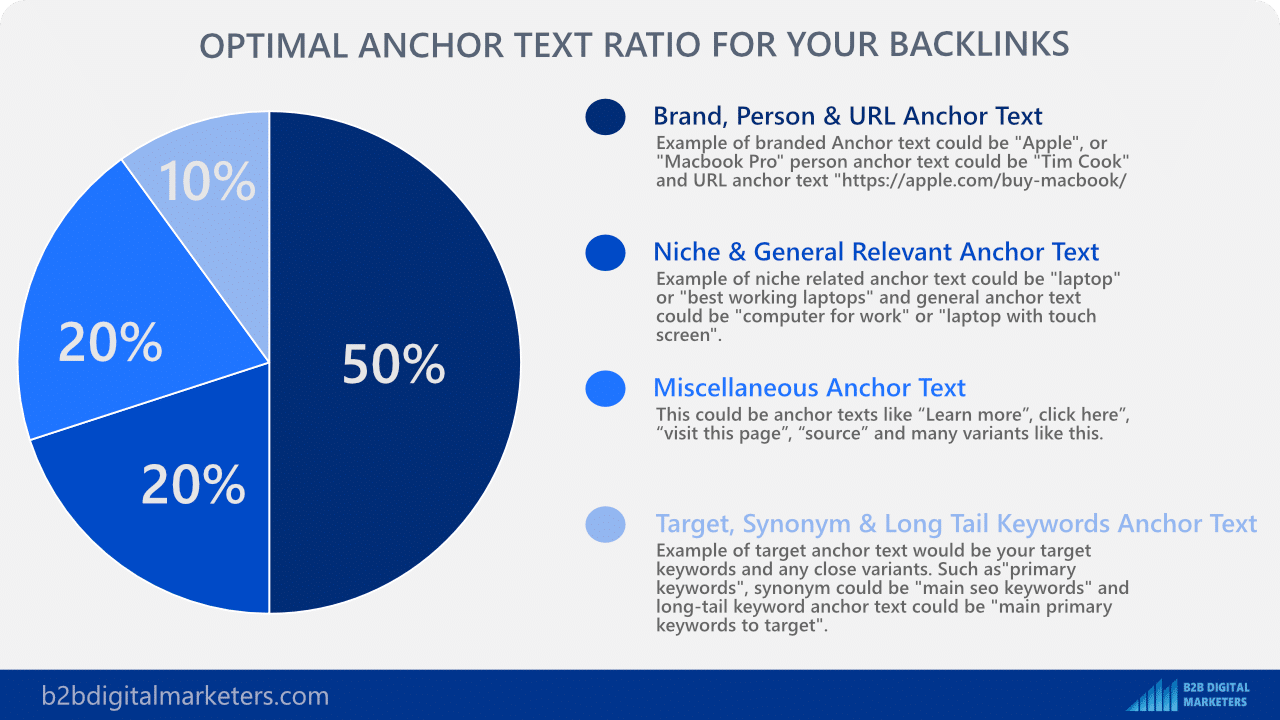
- Start with Similar Website Authority: When you are using any link building strategies to build backlinks, make sure you build them on a website with similar website authority. For example, if your website authority is 50, build on websites with a website authority of 40-60.

- Start by Focusing on Referring Domains: Once you’ve analyzed your competitors’ backlinks, prioritize building slightly more referring domains (about 10) to those of your top 10 ranking competitors.
- Create 1-2% New Backlinks Each Week: When building new backlinks, limit your efforts to creating only 1-2% of new backlinks per week based on the total number of backlinks for the individual page, not the entire website.
- Repurpose Your Content: Every blog you produce can become an email newsletter, video, social media post, or other marketing materials that can maximize your marketing effort. Using tools such as Jasper AI, Copy AI or Anyword AI will help you to do that faster and better.
- Create Link Baits: Create content that is so compelling and valuable that other websites will naturally link back to it. This could be in the form of a useful tool, an insightful article, or an engaging infographic. By creating link bait, you can naturally attract high-quality backlinks and boost your search engine rankings.
- Become Active on Social Media: Social media is a powerful tool for building brand awareness and driving traffic to your website. Make sure you are active on the platforms where your target audience spends their time, and engage with them regularly through compelling content and conversations.
- Build Brand Mentions or Personal Mentions: Building brand mentions or personal mentions means getting your brand or personal name mentioned on other websites without necessarily getting a backlink. This can still help to boost your search engine rankings and build your brand reputation. One way to do this is to engage in influencer marketing and collaborate with influencers to get your brand or personal name mentioned on their platforms.
With that, Off-page SEO is widely regarded as one of the most challenging aspects of the SEO pyramid, as it involves building links and promoting your website on other websites besides your own. This requires you to build your network, engage with others, and provide valuable content in order to earn backlinks to your site.
It’s important to note that off-page SEO is a crucial component of any successful SEO strategy, and should not be overlooked if you want to achieve results quickly.
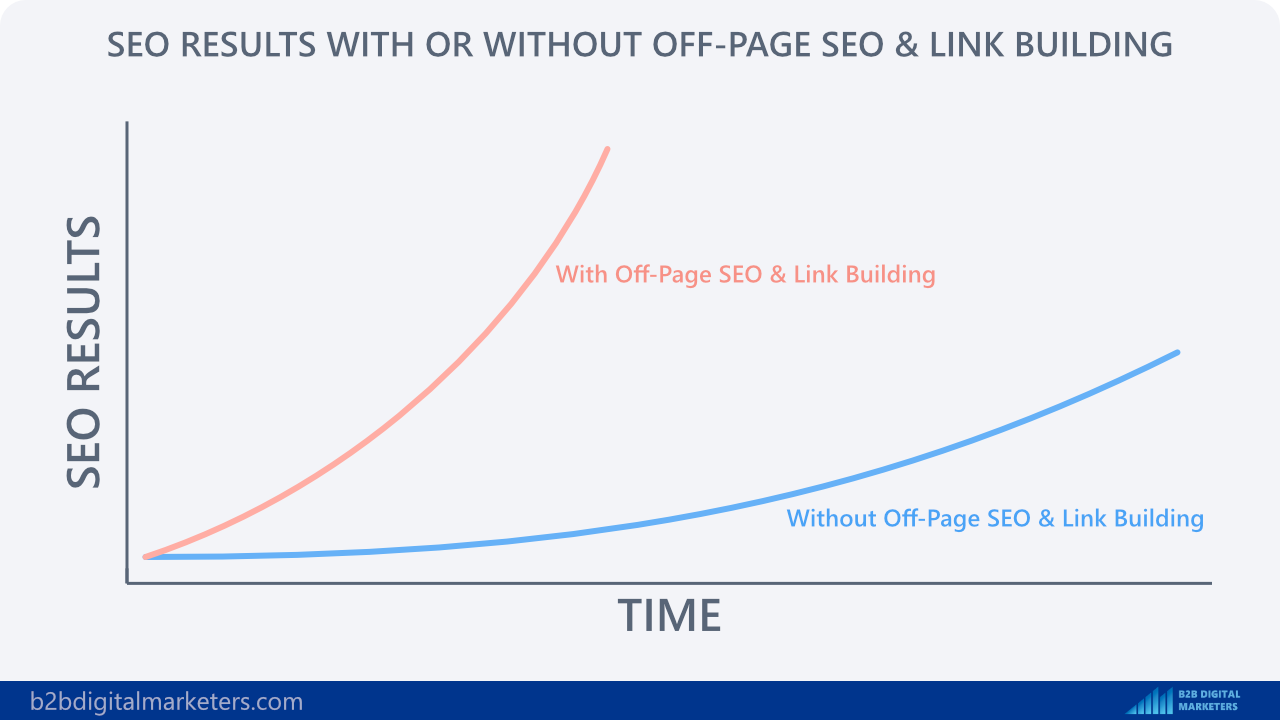
Implementing Local SEO Best Practices
On top of all the SEO components in the SEO pyramid lies Local SEO. Local SEO is focused on optimizing your website for local search results and increasing your visibility to potential customers in your local area.
And while not everybody will need local SEO, most businesses will do, regardless they are targeting international or local customers. Therefore, here are Local SEO best practices to meet Google sitewide rankings for local businesses:
- Have Consistent NAP Listings: One of the biggest issues with Local SEO is inconsistent NAP (Business Name, Address, Phone Number). So, make sure all your business listings have the exact NAP from your Google Business Profile.
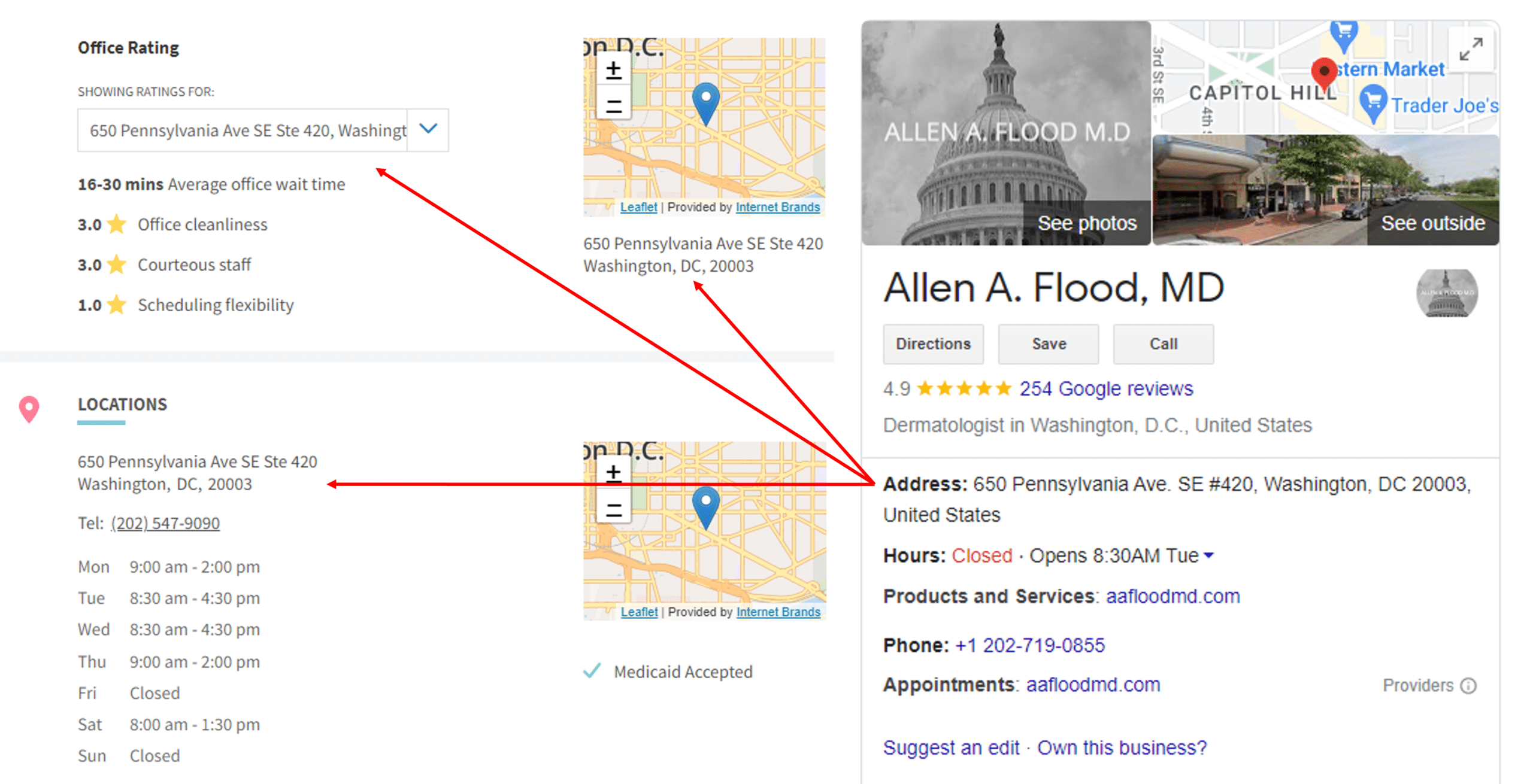
- Collect Reviews from Your Customers: Reviews are essential for you to rank in local search results and attract new customers. Without reviews, customers won’t trust your business and Google either.
- Ask Them to Include “Keyword” Reviews: Having reviews with relevant keywords to your products or services is an excellent way to improve your ranking. For example, ask them “Hey John, would you mind sharing your thoughts on the Vacuum Sucker 3000 here.”
- Maximize Google Business Profile: GBP is the #1 way used by Google to better understand what’s your website about, and what products or services you are offering. This will ultimately help you improve your ranking.
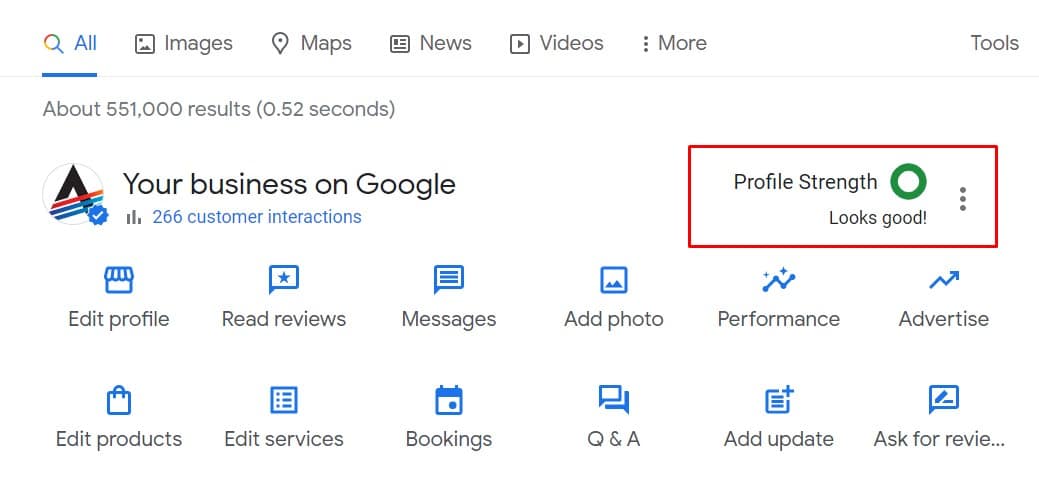
- Target Local Keywords: Targeting local keywords is arguably the easiest way to start ranking as it is often less competitive. Additionally, they also bring better quality leads for your business. So, start locally, and expand globally.
- Create Local Events: Hosting local events can help you to build relationships with customers, increase brand awareness, and generate valuable backlinks to your website. For example, you could sponsor a local charity event or organize a neighborhood cleanup.
- Do Local Link Building: Building high-quality links from other local websites can help to boost your local SEO ranking. You can reach out to other local businesses, organizations, or bloggers and ask them to link to your website.
- Use Structure Data: Using structured data such as Organization, local services, etc. will help search engines to better understand what’s your website about. Additionally, it can help you appear for rich results such as featured snippets, knowledge graphs, and local pack listings.
- Have Always-On Messaging: Ensure that your messaging is always on, meaning that your business is always available and responsive to customer inquiries, reviews, and feedback.
- Monitor Local Trends: Being responsive to local trends and events can help you to break through the noise and get some attention from local customers as well as from local newspapers resulting in more customers and backlinks for your website.
- Get Listed on Local Directories: Search engines are using local directories to better understand what’s your website about and what services or products you are offering and it can be used when they are assessing your website for ranking for relevant keywords.
Overall, local SEO hides plenty of opportunities to grow your website’s organic traffic, lead generation, and business revenue. Therefore, you should try to think of ways how you can optimize your website for local SEO to satisfy even more Google Sitewide signals.
5 Benefits of SEO Pyramid
SEO Pyramid is important because it provides a systematic approach to search engine optimization that ensures you’re covering all the necessary bases and you are optimizing for most of the search engine ranking signals to improve your website’s search engine visibility and rankings.
With that here are the most important benefits of the SEO pyramid:
1. Optimize for Sitewide Signals
Arguably the biggest benefit of the SEO pyramid is that it enables you to optimize for Google sitewide signals.
Website authority is not built only via backlinks and as said by John Mueller:
In general, Google doesn’t evaluate a site’s authority. So, it’s not something where we would give you a score on authority and say this is the general score for authority on your website. That’s not something we would be applying here.
Instead, Google is using hundreds and perhaps even thousands of different sitewide ranking signals to rank each individual page on your website against Panda, Penguin, MUM, RankBrain, and your page speed, website security, URL, quality of content, authors, keyword placement, internal and external links, backlinks, reviews, and many, many more.
This means that whenever you publish new content on your website, Google scans the page and evaluates it against a range of ranking factors specific to your domain and the new page. Based on this assessment, Google assigns a ranking to your page.
That’s why, it usually takes 1-2 weeks for your page to start ranking, as Google must not only process the content, but many other signals to determine where to rank your content.
And SEO pyramid helps you to optimize your entire website and each individual page for most of the Google ranking factors in a systematic manner.
By focusing on optimizing sitewide signals, you can improve the overall authority and credibility of your website, which in turn can positively impact the ranking of all pages on your site.
2. Improved Website Ranking & Visibility
Another benefit of SEO is that it can help improve your website’s ranking and visibility in search engine results pages (SERPs).
By following the SEO pyramid, your website, and its content will be properly optimized for search engine ranking algorithms resulting in a much bigger chance of ranking on the first page of search results for your relevant keywords and phrases.
And the higher your website ranks in search results, the more organic traffic you can bring and the more visible your brand is to your target audience which can increase lead generation for your business.
Research shows that websites on the first page of search results receive significantly more clicks than those on subsequent pages, with the top three results receiving the lion’s share of clicks.
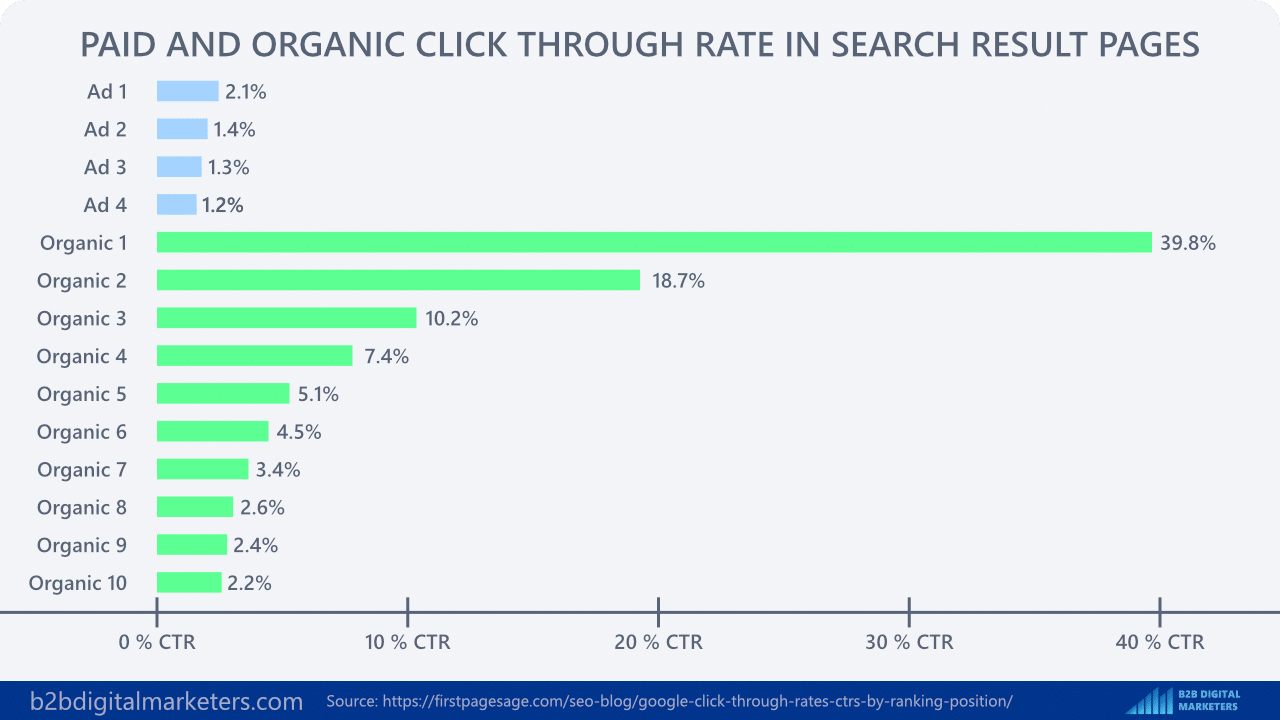
By implementing SEO Pyramid strategic framework and focusing on each level of the pyramid, you can create a solid foundation for your website’s search engine optimization efforts and see your SEO results much faster.
3. Increase Organic Traffic
The next SEO pyramid benefit is that it can help increase organic traffic to your website.
By optimizing your website and content for search engines algorithm using the SEO pyramid framework, you can improve your website’s ranking and visibility in search results, which can lead to more clicks and visits from potential customers.
Obviously, the higher your website ranks for the target keyword the more clicks it will receive in SERPs, resulting in more organic website traffic to your website.
In fact, studies show that for most businesses organic traffic is responsible for the majority of their website traffic.
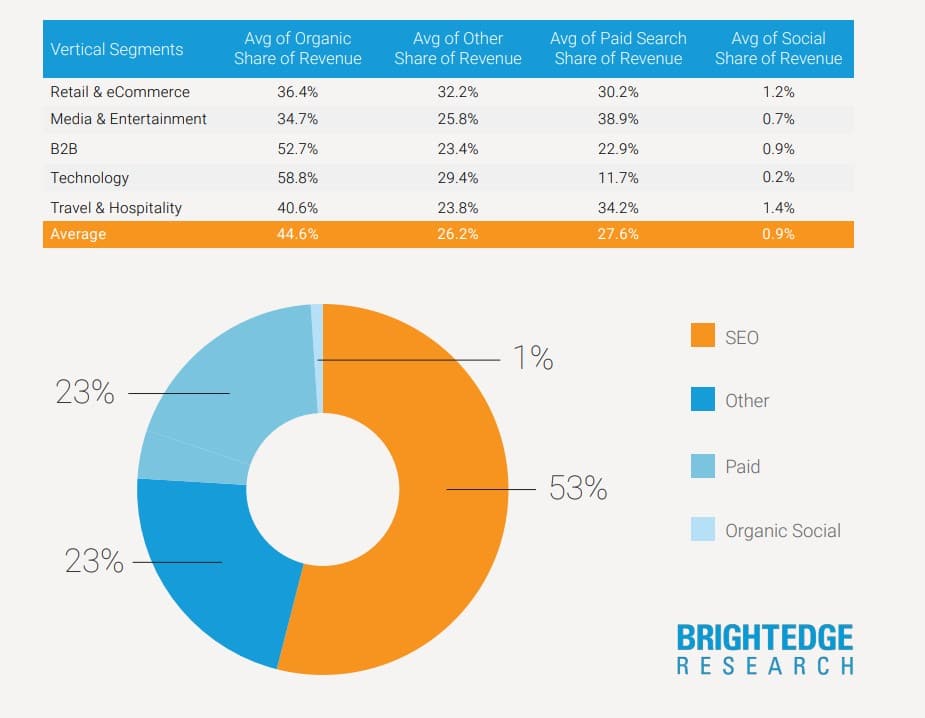
With that being said, by focusing on all the SEO components within the SEO pyramid, you can improve your website’s search engine visibility and increase the likelihood that people will find and visit your site.
4. Better SEO Process
Another benefit of the SEO pyramid is that it can help businesses develop a better and more effective SEO process.
SEO Pyramid can help you develop and structure the SEO process to improve website ranking, organic traffic, user engagement, lead generation, and all the necessary elements of SEO in the most efficient and effective way possible resulting in better SEO results with lesser effort.
By using the SEO pyramid, you will be able to address all the key SEO elements and develop an SEO strategy for any of your SEO projects in a structured and systematic approach and more easily measure and track your progress over time.
An SEO process like this enables you to deliver more predictable and consistent results in terms of search engine rankings and traffic, which can be a huge benefit for businesses looking to establish a strong online presence.
5. Long-Term Sustainability of SEO Efforts
And the last benefit of the SEO pyramid is that it can help businesses achieve long-term sustainability with their SEO efforts.
By following a structured and systematic approach to SEO, businesses can build a strong foundation that can support ongoing success and growth over time and help businesses establish a solid SEO foundation that can stand the test of Google algorithm updates.
Overall, the benefit of achieving long-term sustainability with SEO efforts that can result from using the SEO pyramid approach can help businesses establish a strong online presence that can drive leads, sales, and revenue over the long term.
Final Advice to SEO Pyramid
As said, the SEO pyramid is a strategic, systematic approach used by SEOs to deliver predictable SEO results.
And, even if you have already created a website and did not follow the SEO pyramid approach, you can use it as a framework and revisit each of the SEO components within the SEO pyramid and optimize it.
Through this, you can uncover any reasons why your website is not ranking and what is the cause of not being able to penetrate the top-ranking positions and subsequently come up with an SEO plan that will help you fix that.
Therefore, use this as an SEO checklist to ensure that your or your client’s website is fully optimized for search engines to deliver predictable and great SEO results!
Related Articles:
- How Long Does It Take to Learn SEO?
- 12 Best Surfer SEO Alternatives & Competitors (Free & Paid)
- 7 Best Copy AI Alternatives (Free & Paid)
- How To Check Website Position in Google
- How to Find Keywords on a Website
- B2B Blogging: Best Practices, Tips and Tricks
- How To Track Keyword Ranking
Also, check out our SEO hub page to find all our SEO resources.
Disclaimer
This article was created by Eduard Dziak and may contain affiliate links. The following were used to optimize the article for the best user and search engine experience include:
- SE Ranking for keyword research and on-page SEO optimization
- Surfer SEO for SEO-friendly content creation for users and search engines.
- Jasper AI for grammar correction and information enhancement.
The article is based on the author’s own experience and knowledge, drawn from both their own work and that of their clients, to provide the latest, proven methods.
Support the B2BDigitalMarketers
Hey, Eduard here.
As a solo blogger with limited resources, I need your support to keep creating in-depth SEO content like this. Please consider joining my Patreon community to help this site grow.
Your pledge – no matter how small – will enable me to dedicate more time to sharing actionable tips and strategies. With your help, I can take this project to the next level and really make a difference for other SEOs and marketers.
I would sincerely appreciate you joining me on this journey as a founding patron. Together, we can build an amazing resource hub. Hope to see you on the inside – thanks for your trust and support!








